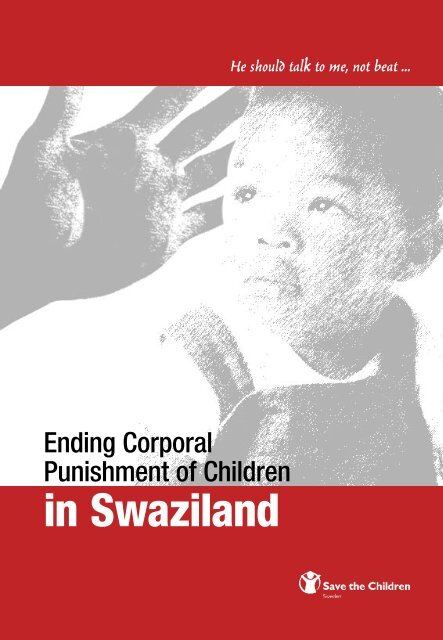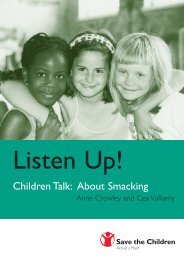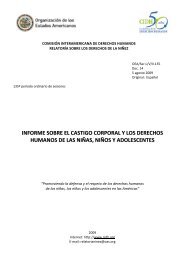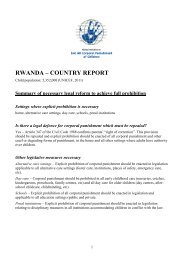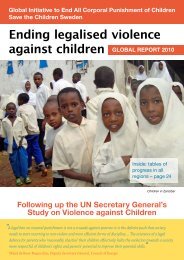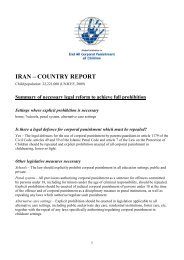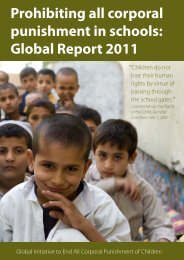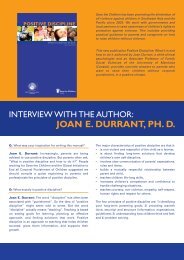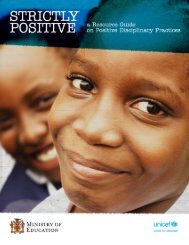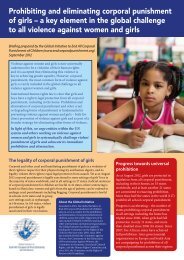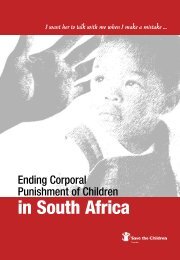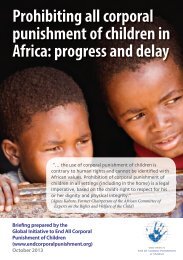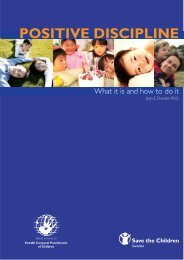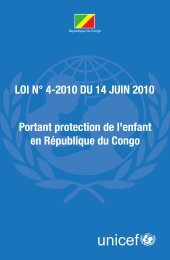Ending corporal punishment of children in Swaziland
Ending corporal punishment of children in Swaziland
Ending corporal punishment of children in Swaziland
- No tags were found...
You also want an ePaper? Increase the reach of your titles
YUMPU automatically turns print PDFs into web optimized ePapers that Google loves.
<strong>End<strong>in</strong>g</strong> CorporalPunishment <strong>of</strong> Children<strong>in</strong> <strong>Swaziland</strong>
Save the Children Sweden fights for <strong>children</strong>’s rights. We <strong>in</strong>fluence public op<strong>in</strong>ionand support <strong>children</strong> at risk <strong>in</strong> Sweden and <strong>in</strong> the world.The vision <strong>of</strong> Save the Children Sweden is:• a world which respects and values each child;• a world which listens to <strong>children</strong> and learns;• a world where all <strong>children</strong> have hope and opportunity.Published by:Save the Children SwedenRegional Office for Southern AfricaPO Box 40788Arcadia, 0007Telephone: +27 (0)12 341 1186Fax: +27 (0)12 341 1125E-mail: postmaster@za.rb.seWeb: http://www.rb.seCopyright Save the Children SwedenPublished <strong>in</strong> May 2005Author:Ms Ulrika Soneson, Save the Children Sweden, PretoriaEdited by:Ms Charma<strong>in</strong>e Smith, Cape TownDesigned by:Market<strong>in</strong>g Support Services CC, PretoriaDraw<strong>in</strong>gs <strong>in</strong>side the publication:Children who participated <strong>in</strong> the survey on <strong>children</strong>’s views and experiences <strong>of</strong><strong>corporal</strong> and humiliat<strong>in</strong>g <strong>punishment</strong> discussed <strong>in</strong> chapter 5 drew the pictures <strong>in</strong>sidethis publication.ISBN: 0-620-34220-XTo order additional copies please contact Save the Children Sweden on theaddress mentioned above.
<strong>End<strong>in</strong>g</strong> CorporalPunishment <strong>of</strong> Children<strong>in</strong> <strong>Swaziland</strong>May 2005
TABLE OF CONTENTAbbreviations 41. Introduction 52. Def<strong>in</strong>ition <strong>of</strong> <strong>corporal</strong> <strong>punishment</strong> and other forms <strong>of</strong>humiliat<strong>in</strong>g and degrad<strong>in</strong>g <strong>punishment</strong> <strong>of</strong> <strong>children</strong> 63. Why is <strong>corporal</strong> and humiliat<strong>in</strong>g <strong>punishment</strong> <strong>of</strong><strong>children</strong> wrong? 84. How common is <strong>corporal</strong> and humiliat<strong>in</strong>g <strong>punishment</strong><strong>of</strong> <strong>children</strong> <strong>in</strong> <strong>Swaziland</strong>? 105. Children’s views <strong>of</strong> <strong>corporal</strong> <strong>punishment</strong> and other forms<strong>of</strong> humiliat<strong>in</strong>g and degrad<strong>in</strong>g <strong>punishment</strong> 126. <strong>Swaziland</strong>’s <strong>in</strong>ternational obligations 187. <strong>Swaziland</strong>’s national laws 208. Frequently used arguments justify<strong>in</strong>g <strong>corporal</strong> <strong>punishment</strong> 229. Alternatives to <strong>corporal</strong> <strong>punishment</strong> and other forms <strong>of</strong>humiliat<strong>in</strong>g and degrad<strong>in</strong>g punsihment 2710. Conclusion and recommendations 29Useful contacts 33End notes 34
ABBREVIATIONSACRWCCBOCRCNGOUNAfrican Charter on the Rights and Welfare <strong>of</strong> the ChildCommunity-Based OrganisationUN Convention on the Rights <strong>of</strong> the ChildNon-Governmental OrganisationUnited Nations4
1. INTRODUCTION“He should talk to me, not beat.” 1Girl, 9-12-year age groupAs <strong>in</strong> so many other countries <strong>in</strong> the world, many <strong>children</strong> <strong>in</strong> <strong>Swaziland</strong> suffer<strong>corporal</strong> <strong>punishment</strong> and other forms <strong>of</strong> humiliat<strong>in</strong>g and degrad<strong>in</strong>g <strong>punishment</strong> <strong>in</strong>the home, <strong>in</strong> the school and <strong>in</strong> different <strong>in</strong>stitutions.Less than 20 countries worldwide have adopted legislation to prohibit <strong>corporal</strong><strong>punishment</strong> <strong>of</strong> <strong>children</strong>. In addition, a number <strong>of</strong> countries have outlawed <strong>corporal</strong><strong>punishment</strong> <strong>of</strong> <strong>children</strong> <strong>in</strong> schools and other <strong>in</strong>stitutions. The global movementto reverse the culture <strong>of</strong> <strong>corporal</strong> <strong>punishment</strong> and other forms <strong>of</strong> humiliat<strong>in</strong>g anddegrad<strong>in</strong>g <strong>punishment</strong> <strong>of</strong> <strong>children</strong> is ga<strong>in</strong><strong>in</strong>g momentum. It is based on a grow<strong>in</strong>gunderstand<strong>in</strong>g <strong>of</strong> <strong>children</strong> as holders <strong>of</strong> rights, and the grow<strong>in</strong>g body <strong>of</strong> evidencefrom medical, educational and psychological authorities on the negative effects <strong>of</strong><strong>corporal</strong> <strong>punishment</strong> and its <strong>in</strong>effectiveness as a method <strong>of</strong> discipl<strong>in</strong>e.Corporal <strong>punishment</strong> <strong>of</strong> <strong>children</strong> violates <strong>children</strong>’s human rights to physical <strong>in</strong>tegrityand human dignity, as upheld by the UN Convention on the Rights <strong>of</strong> the Child(CRC) and the African Charter on the Rights and Welfare <strong>of</strong> the Child (ACRWC).It is the obligation <strong>of</strong> all states around the world to ensure that <strong>children</strong>’s right to alife free from violence, <strong>in</strong>clud<strong>in</strong>g <strong>corporal</strong> <strong>punishment</strong> and other forms <strong>of</strong> humiliat<strong>in</strong>gand degrad<strong>in</strong>g <strong>punishment</strong>, is protected. Children’s right to a life free from violencealso extends <strong>in</strong>to the private life and home <strong>of</strong> the child.Defenders <strong>of</strong> <strong>corporal</strong> <strong>punishment</strong> suggest that <strong>children</strong> are different. But theirdifferences – their dependence, developmental state and fragility – do not reducetheir human rights or justify less protection from all forms <strong>of</strong> violence, <strong>in</strong>clud<strong>in</strong>g<strong>corporal</strong> <strong>punishment</strong>. 2This publication aims to provide <strong>in</strong>formation about <strong>corporal</strong> <strong>punishment</strong> and otherforms <strong>of</strong> humiliat<strong>in</strong>g and degrad<strong>in</strong>g <strong>punishment</strong> <strong>of</strong> <strong>children</strong> <strong>in</strong> <strong>Swaziland</strong>. It outl<strong>in</strong>es<strong>in</strong>ternational obligations to prohibit the <strong>corporal</strong> <strong>punishment</strong> <strong>of</strong> <strong>children</strong> and toengage <strong>in</strong> public education. It provides recommendations on steps to be taken bythe government and civil society to ensure that the culture <strong>of</strong> <strong>corporal</strong> <strong>punishment</strong>and other forms <strong>of</strong> humiliat<strong>in</strong>g and degrad<strong>in</strong>g <strong>punishment</strong> <strong>of</strong> <strong>children</strong> is replaced bypositive, non-violent forms <strong>of</strong> discipl<strong>in</strong>e based on respect for <strong>children</strong>’s rights.In this publication, a child is referred to as a person below the age <strong>of</strong> 18 years <strong>in</strong>accordance with the CRC.5
2. DEFINITION OF CORPORAL PUNISHMENTAND OTHER FORMS OF HUMILIATING ANDDEGRADING PUNISHMENT OF CHILDRENSave the Children identifies two categories <strong>of</strong> <strong>punishment</strong> <strong>of</strong> <strong>children</strong> that canoccur separately or together, i.e. <strong>corporal</strong> or physical <strong>punishment</strong>, and humiliat<strong>in</strong>gor degrad<strong>in</strong>g <strong>punishment</strong>. Both forms <strong>of</strong> <strong>punishment</strong> constitute violations <strong>of</strong><strong>children</strong>’s rights.Corporal or physical <strong>punishment</strong> <strong>of</strong> <strong>children</strong> and the threat <strong>of</strong> it <strong>in</strong>cludes hitt<strong>in</strong>gthe child with the hand or with an object (such as a cane, belt, whip, shoe, etc.);kick<strong>in</strong>g, shak<strong>in</strong>g, or throw<strong>in</strong>g the child; p<strong>in</strong>ch<strong>in</strong>g or pull<strong>in</strong>g their hair; forc<strong>in</strong>g achild to stay <strong>in</strong> uncomfortable or undignified positions, or to take excessive physicalexercise; and burn<strong>in</strong>g or scarr<strong>in</strong>g the child.“I wanted to go to church. They hit me with a knobkerrie, and said Ishould take the goats to the mounta<strong>in</strong>. I ran away.” 3Boy, 9-12-year age groupHumiliat<strong>in</strong>g or degrad<strong>in</strong>g <strong>punishment</strong> <strong>of</strong> <strong>children</strong> takes various forms, such aspsychological <strong>punishment</strong>, verbal abuse, ridicule, isolation, or ignor<strong>in</strong>g the child.“I spilt my mom’s water <strong>in</strong> the refrigerator.She shouted at me and said I was not go<strong>in</strong>g to sleep <strong>in</strong> her home.” 4Girl, 6-8-year age groupIt is important to note that there is no clear l<strong>in</strong>e between <strong>corporal</strong> <strong>punishment</strong>and humiliat<strong>in</strong>g or degrad<strong>in</strong>g <strong>punishment</strong>. Very <strong>of</strong>ten <strong>children</strong> perceive <strong>corporal</strong><strong>punishment</strong> as also be<strong>in</strong>g humiliat<strong>in</strong>g or degrad<strong>in</strong>g.“Did not come to school, as I had attended Tibiyo Bursary <strong>in</strong>terviews;so I was beaten six times on the buttocks. I felt depressed, humiliated,punished for no good reason.” 5Boy, 13-18- year age groupNon-<strong>corporal</strong> forms <strong>of</strong> <strong>punishment</strong>, such as mak<strong>in</strong>g <strong>children</strong> do heavy physicallabour or stay<strong>in</strong>g <strong>in</strong> degrad<strong>in</strong>g or uncomfortable positions, also constitute<strong>corporal</strong> <strong>punishment</strong>.A range <strong>of</strong> different words are used to describe the use <strong>of</strong> physical force aga<strong>in</strong>st<strong>children</strong>. Common examples are hitt<strong>in</strong>g, slapp<strong>in</strong>g or smack<strong>in</strong>g, ‘a good beat<strong>in</strong>g’, ‘six<strong>of</strong> the best’, a thrash<strong>in</strong>g, or ‘a good hid<strong>in</strong>g’.Very <strong>of</strong>ten adults are mak<strong>in</strong>g statements such as, “I just gave my child a light smack.That is not child abuse, because I know what is best for my child. I only wanted to6
correct his/her behaviour”. All forms <strong>of</strong> <strong>corporal</strong> <strong>punishment</strong> <strong>of</strong> <strong>children</strong>, howeverlight, constitute violence aga<strong>in</strong>st the child. Corporal <strong>punishment</strong> is one form <strong>of</strong>violence aga<strong>in</strong>st <strong>children</strong>, or child abuse. It is not a separate method <strong>of</strong> discipl<strong>in</strong>eused by parents, teachers or other care givers as they see fit.While <strong>corporal</strong> <strong>punishment</strong> is more visible, emotional <strong>punishment</strong> <strong>in</strong> the form <strong>of</strong>humiliat<strong>in</strong>g or degrad<strong>in</strong>g treatment is more difficult to identify and confront as forms<strong>of</strong> child abuse. Discipl<strong>in</strong><strong>in</strong>g a child by send<strong>in</strong>g him or her outside to stand <strong>in</strong> thesun for hours, to underm<strong>in</strong>e a child’s self-esteem or to deny a child food or cloth<strong>in</strong>gis as damag<strong>in</strong>g as different forms <strong>of</strong> <strong>corporal</strong> <strong>punishment</strong>.7
3. WHY IS CORPORAL AND HUMILIATINGPUNISHMENT OF CHILDREN WRONG?Over the last decades, the world has recognised that people are entitled to basichuman rights. International and regional bodies such as the United Nations and theAfrican Union have developed standards for the respect <strong>of</strong> people’s basic humanrights. Hitt<strong>in</strong>g and deliberately humiliat<strong>in</strong>g people violate their fundamental rights torespect for their physical <strong>in</strong>tegrity and human dignity.Children are bearers <strong>of</strong> human rights from the moment <strong>of</strong> their birth, and they areentitled to physical <strong>in</strong>tegrity and human dignity <strong>in</strong> the same way as adults. Childrenare human be<strong>in</strong>gs that are simply smaller and more fragile than adults. 6Corporal <strong>punishment</strong> and other forms <strong>of</strong> humiliat<strong>in</strong>g and degrad<strong>in</strong>g <strong>punishment</strong>breach <strong>children</strong>’s fundamental human rights to respect for human dignity andphysical <strong>in</strong>tegrity. This has been confirmed <strong>in</strong> <strong>in</strong>ternational human rights <strong>in</strong>strumentssuch as the CRC and the ACRWC (for further <strong>in</strong>formation see chapter 6).Despite be<strong>in</strong>g <strong>in</strong> contradiction <strong>of</strong> <strong>in</strong>ternational law, <strong>corporal</strong> <strong>punishment</strong> and otherforms <strong>of</strong> humiliat<strong>in</strong>g and degrad<strong>in</strong>g <strong>punishment</strong> are <strong>in</strong> many <strong>in</strong>stances still legalisedand socially-accepted forms <strong>of</strong> violence aga<strong>in</strong>st <strong>children</strong>. The low status <strong>of</strong> <strong>children</strong><strong>in</strong> society and <strong>children</strong>’s lack <strong>of</strong> power have prevented a complete prohibition <strong>of</strong><strong>corporal</strong> <strong>punishment</strong> <strong>in</strong> many countries around the world, <strong>in</strong>clud<strong>in</strong>g <strong>Swaziland</strong>.In addition to breach<strong>in</strong>g <strong>children</strong>’s basic human rights, there is also a body <strong>of</strong>evidence from medical, educational and psychological authorities on the negativeeffects <strong>of</strong> <strong>corporal</strong> <strong>punishment</strong> <strong>of</strong> <strong>children</strong>.Studies have shown a significant, positive correlation between the frequency <strong>of</strong><strong>in</strong>terpersonal violence experienced as a child and the approval <strong>of</strong> the use <strong>of</strong> <strong>in</strong>terpersonalviolence as an adult. 7 A South African national household survey also found that parentswho agreed with the <strong>corporal</strong> <strong>punishment</strong> <strong>of</strong> <strong>children</strong> were more likely to experiencehigher levels <strong>of</strong> partner violence than parents who disagreed with <strong>corporal</strong> <strong>punishment</strong>. 8There is strong evidence that <strong>corporal</strong> <strong>punishment</strong> places <strong>children</strong> at risk <strong>of</strong> physical<strong>in</strong>jury, poorer mental health, impaired relationships with parents, weaker <strong>in</strong>ternalisation<strong>of</strong> moral values, anti-social behaviour, and poorer adult adjustment. 9In <strong>Swaziland</strong>, <strong>in</strong>terpersonal violence is widespread. The use <strong>of</strong> <strong>corporal</strong> <strong>punishment</strong>on <strong>children</strong> contributes to a perception from an early age that violence is anappropriate response to conflict and unwanted behaviour. It teaches that it isacceptable for powerful persons to be violent towards the weak and to solveconflicts through violence.A survey among <strong>children</strong> <strong>in</strong> <strong>Swaziland</strong> <strong>in</strong>dicated that the <strong>corporal</strong> <strong>punishment</strong> <strong>of</strong><strong>children</strong> can also elicit aggressive behaviour. 108
“My elder brother beat me. He hit me aga<strong>in</strong>st the wall and clappedme. I really don’t know, he likes beat<strong>in</strong>g me and for this I am worried.I f<strong>in</strong>d no peace <strong>in</strong> my life. I feel miserable. I feel sad, and each time Ith<strong>in</strong>k about it I feel sad. I want to commit suicide and never see himaga<strong>in</strong>. I felt like kill<strong>in</strong>g him with my bare hands.”Girl 13-18-year age groupResearch shows that <strong>corporal</strong> <strong>punishment</strong> is not an effective way to ensure change<strong>of</strong> behaviour and discipl<strong>in</strong>e among <strong>children</strong>. If <strong>corporal</strong> <strong>punishment</strong> ‘works’ as adeterrent, it should stop unwanted behaviour among ‘difficult’ <strong>children</strong>. However, ithas been established that <strong>in</strong> schools where <strong>corporal</strong> <strong>punishment</strong> is used, the samelearners are be<strong>in</strong>g beaten for the same <strong>of</strong>fences over and over aga<strong>in</strong>. Classes withthe fewest behavioural problems over time are run by teachers who are committedto non-violent and child-centred approaches to classroom discipl<strong>in</strong>e. 11Corporal <strong>punishment</strong> works aga<strong>in</strong>st the process <strong>of</strong> ethical development. It teaches<strong>children</strong> not to engage <strong>in</strong> a particular behaviour because they will be beaten.It does not teach them to consider the reasons and ethics for not behav<strong>in</strong>g <strong>in</strong> aparticular manner. 12It is also important to remember that a large number <strong>of</strong> <strong>children</strong> engage <strong>in</strong> unwantedbehaviour due to practical problems, for example hunger, thirst, lack <strong>of</strong> rest dueto hav<strong>in</strong>g to walk long distances to school, stressful or abusive family situations,medical problems, or car<strong>in</strong>g for a sick parent and tak<strong>in</strong>g care <strong>of</strong> sibl<strong>in</strong>gs due to theHIV/AIDS pandemic. By us<strong>in</strong>g a ‘quick fix’ such as <strong>corporal</strong> <strong>punishment</strong> and otherforms <strong>of</strong> humiliat<strong>in</strong>g and degrad<strong>in</strong>g <strong>punishment</strong>, an adult might miss the opportunityto deal with the actual problem fac<strong>in</strong>g the child. 13 This might lead to a situationwhere <strong>children</strong>’s rights to food, health care and education are violated <strong>in</strong> additionto their right to physical <strong>in</strong>tegrity.9
4. HOW COMMON IS CORPORAL ANDHUMILIATING PUNISHMENT OF CHILDRENIN SWAZILAND?There is almost no statistical <strong>in</strong>formation available on attitudes to and the use <strong>of</strong><strong>corporal</strong> and humiliat<strong>in</strong>g <strong>punishment</strong> on <strong>children</strong> <strong>in</strong> different sett<strong>in</strong>gs such as thehome, the school and different <strong>in</strong>stitutions <strong>in</strong> <strong>Swaziland</strong>. However, a quantitativeand qualitative survey <strong>of</strong> 2 750 Swazi <strong>children</strong> – discussed further <strong>in</strong> chapter 5– <strong>in</strong>dicates clearly that <strong>corporal</strong> <strong>punishment</strong> and other forms <strong>of</strong> humiliat<strong>in</strong>g anddegrad<strong>in</strong>g <strong>punishment</strong> <strong>of</strong> <strong>children</strong> are widely practised <strong>in</strong> <strong>Swaziland</strong>.In 2005, a quantitative and qualitative survey <strong>of</strong> 2 750 Swazi boys and girls aged 6-18years explored their experiences, views and feel<strong>in</strong>gs related to <strong>corporal</strong> <strong>punishment</strong>and other forms <strong>of</strong> humiliat<strong>in</strong>g and degrad<strong>in</strong>g <strong>punishment</strong>. It is important to keep<strong>in</strong> m<strong>in</strong>d that the survey looked at <strong>corporal</strong> and humiliat<strong>in</strong>g <strong>punishment</strong> <strong>of</strong> <strong>children</strong>experienced over a period <strong>of</strong> two weeks when compar<strong>in</strong>g the f<strong>in</strong>d<strong>in</strong>gs <strong>of</strong> this surveywith other surveys, which might have used different time frames. 14Eighteen percent <strong>of</strong> <strong>children</strong> reported be<strong>in</strong>g subjected to <strong>corporal</strong> <strong>punishment</strong> <strong>in</strong> thehome, <strong>in</strong> the form <strong>of</strong> be<strong>in</strong>g hit with the hand dur<strong>in</strong>g the two-week period. Twentyeightpercent <strong>of</strong> <strong>children</strong> experienced <strong>corporal</strong> <strong>punishment</strong> <strong>in</strong> the form <strong>of</strong> be<strong>in</strong>g beatenwith objects such as sticks, belts, sjamboks and whips dur<strong>in</strong>g the same period. 15“I was beaten by my mother with a belt that has some metal on it.She hit me 100 times on my buttocks. I broke a glass.”Boy, 6-8-year age groupMoreover, the survey po<strong>in</strong>ts to the fact that <strong>corporal</strong> <strong>punishment</strong>, <strong>in</strong> many <strong>in</strong>stancesus<strong>in</strong>g an object such as a stick, cane or sjambok, is be<strong>in</strong>g practised by a largenumber <strong>of</strong> teachers as a way <strong>of</strong> discipl<strong>in</strong><strong>in</strong>g pupils. Corporal <strong>punishment</strong> is usedto a much greater extent at school than <strong>in</strong> the home. Twenty percent <strong>of</strong> <strong>children</strong>reported be<strong>in</strong>g hit with a hand and 59% <strong>of</strong> <strong>children</strong> reported be<strong>in</strong>g beaten with anobject at school dur<strong>in</strong>g the same two-week period. 16“The head teacher hit me 11 times on the same hand with a stick.I had not worn the tassels worn by maidens to observe chastity rite.”Girl, 13-18-year age groupIt furthermore <strong>in</strong>dicates that <strong>children</strong> are frequently subjected to humiliat<strong>in</strong>g anddegrad<strong>in</strong>g <strong>punishment</strong> <strong>in</strong> the home and at school. Thirty-five percent <strong>of</strong> <strong>children</strong>reported be<strong>in</strong>g exposed to humiliat<strong>in</strong>g <strong>punishment</strong> at home, while 25% haveexperienced this form <strong>of</strong> <strong>punishment</strong> at school. Examples <strong>of</strong> humiliat<strong>in</strong>g <strong>punishment</strong>related to verbal abuse, name-call<strong>in</strong>g as well as isolation from the home orfamily. Corporal <strong>punishment</strong> adm<strong>in</strong>istered <strong>in</strong> front <strong>of</strong> others was also perceivedas humiliat<strong>in</strong>g. 1710
“I was walk<strong>in</strong>g around with my shirt untagged. The teacher called me tothe staff room and made me pull up my shirt, open my pants and tuck<strong>in</strong> my shirt, then fasten it. Then open my pants, you know open my zipand this was done at lunch-time when teachers were com<strong>in</strong>g <strong>in</strong>.”Boy, 13-18-year age groupChildren from low <strong>in</strong>come environments generally experience <strong>corporal</strong> <strong>punishment</strong>and other forms <strong>of</strong> humiliat<strong>in</strong>g and degrad<strong>in</strong>g <strong>punishment</strong> to a greater extent than<strong>children</strong> from high <strong>in</strong>come environments. 18There was a consistent trend, statistically significant <strong>in</strong> four out <strong>of</strong> six comparisons,for <strong>corporal</strong> <strong>punishment</strong> to be used more frequently on younger <strong>children</strong> than onolder <strong>children</strong>. Older <strong>children</strong> experience humiliat<strong>in</strong>g and degrad<strong>in</strong>g <strong>punishment</strong> toa greater extent than younger <strong>children</strong>. 19The study found no statistically significant difference between the levels <strong>of</strong> <strong>corporal</strong>and humiliat<strong>in</strong>g <strong>punishment</strong> received by boys and girls, with the exception <strong>of</strong> olderboys who experience humiliat<strong>in</strong>g and degrad<strong>in</strong>g <strong>punishment</strong> at school more <strong>of</strong>tenthan girls. Qualitative data <strong>in</strong>dicates that girls are particularly prone to verbal abuse,as parents attempt to control perceived sexual activities <strong>of</strong> teenage girls. 20In compil<strong>in</strong>g research on the legal status <strong>of</strong> <strong>corporal</strong> <strong>punishment</strong> and other forms<strong>of</strong> humiliat<strong>in</strong>g and degrad<strong>in</strong>g <strong>punishment</strong> <strong>of</strong> <strong>children</strong> <strong>in</strong> <strong>Swaziland</strong>, a questionnairewas adm<strong>in</strong>istrated to 47 adults. Seven <strong>of</strong> the respondents called for a complete ban<strong>of</strong> <strong>corporal</strong> <strong>punishment</strong>, while 17 respondents called for the cont<strong>in</strong>uation <strong>of</strong> allforms <strong>of</strong> <strong>corporal</strong> <strong>punishment</strong>. Some <strong>of</strong> the rema<strong>in</strong><strong>in</strong>g 23 respondents thought thatit should be banned <strong>in</strong> prisons; some thought it should be banned <strong>in</strong> schools, whilehardly any respondent called for a ban <strong>in</strong> the home. All <strong>of</strong> the respondents were<strong>of</strong> the op<strong>in</strong>ion that a complete ban <strong>of</strong> <strong>corporal</strong> <strong>punishment</strong> would not be receivedwell by the country as a whole. It also became clear that, accord<strong>in</strong>g to custom andtradition, <strong>corporal</strong> <strong>punishment</strong> is an <strong>in</strong>tegral part <strong>of</strong> Swazi child-rear<strong>in</strong>g practices. 21For example, it is generally accepted that older persons <strong>in</strong> the society are allowedto smack any child <strong>in</strong> order to correct behaviour and ensure that <strong>children</strong> grow upto become ‘smart’ adults.The <strong>corporal</strong> <strong>punishment</strong> <strong>of</strong> <strong>children</strong> seems to be a generally accepted and deeprootedpractice to discipl<strong>in</strong>e <strong>children</strong>. There is very limited awareness among adults<strong>of</strong> alternative, non-violent methods <strong>of</strong> child-rear<strong>in</strong>g.National surveys compris<strong>in</strong>g both quantitative components and detailed <strong>in</strong>terviewswith adults and <strong>children</strong> on attitudes to and the use <strong>of</strong> <strong>corporal</strong> <strong>punishment</strong> and otherforms <strong>of</strong> humiliat<strong>in</strong>g and degrad<strong>in</strong>g <strong>punishment</strong> <strong>of</strong> <strong>children</strong> should be undertaken<strong>in</strong> <strong>Swaziland</strong> on a regular basis. Such surveys should not only cover these forms <strong>of</strong><strong>punishment</strong> <strong>in</strong> the home and at school, but they should also <strong>in</strong>vestigate the situation<strong>in</strong> child care facilities, prisons and other <strong>in</strong>stitutions. This will make the extent <strong>of</strong>violence aga<strong>in</strong>st <strong>children</strong> visible and also assist government and civil society todesign appropriate <strong>in</strong>terventions to promote non-violent forms <strong>of</strong> discipl<strong>in</strong>e.11
5. CHILDREN’S VIEWS OF CORPORAL PUNISHMENTAND OTHER FORMS OF HUMILIATING ANDDEGRADING PUNSIHMENTResearch and surveys on <strong>children</strong>’s views and experiences <strong>of</strong> <strong>corporal</strong> <strong>punishment</strong>and other forms <strong>of</strong> humiliat<strong>in</strong>g and degrad<strong>in</strong>g <strong>punishment</strong> <strong>in</strong> <strong>Swaziland</strong> are verylimited. The only exception is a quantitative and qualitative survey <strong>of</strong> 2 750 Swazi<strong>children</strong>’s views and experiences <strong>of</strong> these forms <strong>of</strong> <strong>punishment</strong> <strong>in</strong> the home andat school. There is a lack <strong>of</strong> <strong>in</strong>formation on <strong>children</strong>’s views and experiences <strong>of</strong><strong>punishment</strong> <strong>in</strong> child care facilities, prisons, police stations and other <strong>in</strong>stitutions.In 2005, a survey <strong>of</strong> Swazi boys and girls aged 6-18 years explored <strong>children</strong>’sexperiences, views and feel<strong>in</strong>gs <strong>in</strong> relation to <strong>corporal</strong> <strong>punishment</strong> and otherforms <strong>of</strong> humiliat<strong>in</strong>g and degrad<strong>in</strong>g <strong>punishment</strong>. The survey had a quantitativecomponent, which <strong>in</strong>cluded 2 366 <strong>children</strong> from all <strong>of</strong> <strong>Swaziland</strong>’s four regions,and a qualitative component, which <strong>in</strong>cluded 384 <strong>children</strong> from the same fourregions. The quantitative component <strong>of</strong> the survey provides <strong>in</strong>formation about theprevalence <strong>of</strong> <strong>corporal</strong> and humiliat<strong>in</strong>g <strong>punishment</strong>, about levels <strong>of</strong> unacceptability<strong>of</strong> these forms <strong>of</strong> <strong>punishment</strong>, and about forms <strong>of</strong> discipl<strong>in</strong>e preferred by <strong>children</strong>.The qualitative part <strong>of</strong> the survey on the other hand gives more detailed <strong>in</strong>formationabout the subject <strong>in</strong> <strong>children</strong>’s own words and assists <strong>in</strong> <strong>in</strong>terpret<strong>in</strong>g the quantitativedata. The f<strong>in</strong>d<strong>in</strong>gs <strong>of</strong> this survey are complex, with variations <strong>in</strong> how <strong>children</strong>experience, perceive and respond to these forms <strong>of</strong> <strong>punishment</strong>, depend<strong>in</strong>g onfactors such as socio-economic status 22 , age and gender. With<strong>in</strong> this complexity thereare, however, some clear trends. 23It should be noted that the surveylooked at <strong>corporal</strong> <strong>punishment</strong>and other forms <strong>of</strong> humiliat<strong>in</strong>g anddegrad<strong>in</strong>g <strong>punishment</strong> <strong>of</strong> <strong>children</strong>experienced over a period <strong>of</strong> twoweeks. It is important to keep this <strong>in</strong>m<strong>in</strong>d when compar<strong>in</strong>g the f<strong>in</strong>d<strong>in</strong>gs<strong>of</strong> this survey with other surveys,which might have used differenttime frames.It is clear from the study that many boysand girls <strong>of</strong> all ages <strong>in</strong> <strong>Swaziland</strong> experiencehigh levels <strong>of</strong> <strong>corporal</strong> <strong>punishment</strong> andother forms <strong>of</strong> humiliat<strong>in</strong>g and degrad<strong>in</strong>g<strong>punishment</strong> <strong>in</strong> the home and at school. However, <strong>corporal</strong><strong>punishment</strong> – <strong>in</strong> many cases <strong>in</strong> the form <strong>of</strong> severe beat<strong>in</strong>gs withan object – is reported at school by considerable more <strong>children</strong>than at home. 2412
Eighteen percent <strong>of</strong> <strong>children</strong> reported be<strong>in</strong>g subjected to <strong>corporal</strong> <strong>punishment</strong> bybe<strong>in</strong>g hit with the hand <strong>in</strong> the home dur<strong>in</strong>g a period <strong>of</strong> two weeks, and 28% <strong>of</strong><strong>children</strong> experienced <strong>corporal</strong> <strong>punishment</strong> <strong>in</strong> the form <strong>of</strong> be<strong>in</strong>g beaten with objectssuch as sticks, belts, sjamboks and whips dur<strong>in</strong>g the same period. 25“My mother beat me with a belt on my back.I came home late from play<strong>in</strong>g with my friends.”Boy, 9-12-year age group“She locked me <strong>in</strong>to her room and hit me with a stick on my legs.She did not like it that I was play<strong>in</strong>g with water.”Girl, 9-12-year age groupBoys aged 6-12 years described be<strong>in</strong>g beaten for break<strong>in</strong>g th<strong>in</strong>gs, steal<strong>in</strong>g, notlook<strong>in</strong>g after livestock properly, go<strong>in</strong>g out to play <strong>in</strong>stead <strong>of</strong> work<strong>in</strong>g, or play<strong>in</strong>gout too late. Young <strong>children</strong> – ma<strong>in</strong>ly girls – were punished for issues related tohousehold chores. 26 “At home I did not want to look after cattle.I was made to fetch water and they beat me.”Boy, 9-12-year age groupOn many occasions <strong>corporal</strong> <strong>punishment</strong> was l<strong>in</strong>ked to additional <strong>punishment</strong> suchas chores, hard physical labour or withhold<strong>in</strong>g food. 27“I came home from play<strong>in</strong>g soccer later than the expected time<strong>in</strong> the even<strong>in</strong>g. I was beaten with a stick and denied food.”Boy, 13-18-year age group“I had not washed the dishes. My mother beat me, told me toleave home and ordered me to go and plough the fields.”Boy, 9-12-year age groupA number <strong>of</strong> <strong>children</strong> reported be<strong>in</strong>g beaten by parents or relatives while the adultswere under the <strong>in</strong>fluence <strong>of</strong> alcohol. 28“I had come homed dur<strong>in</strong>g late hours by be<strong>in</strong>g held upwith my friends. My aunt was totally <strong>in</strong>toxicated.When I was asked why I came late at night, I tried toexpla<strong>in</strong> but my explanation fell on deaf ears. I was cruellyflogged. I was beaten with a knobkerrie.”Boy, 13-18-year age group.Twenty percent <strong>of</strong> <strong>children</strong> reported be<strong>in</strong>g hit with a hand and 59% <strong>of</strong> <strong>children</strong>reported be<strong>in</strong>g beaten with an object at school dur<strong>in</strong>g the two-week period. Inschools <strong>children</strong> are most <strong>of</strong>ten hit with the hand, sticks, canes, sjamboks andblackboard dusters. 2913
“I was not able to count and I was beaten.I was beaten on my hand five times.”Boy, 6-8 year-age group“Teacher beat me with a big stick on my bums. She said I had nothanded <strong>in</strong> my work, yet I had done so and she did not mark it.”Girl, 9-12-year age groupChildren reported be<strong>in</strong>g subjected to <strong>corporal</strong> <strong>punishment</strong> at school due to mak<strong>in</strong>ga noise or talk<strong>in</strong>g <strong>in</strong> class, com<strong>in</strong>g late at school, not complet<strong>in</strong>g work, not do<strong>in</strong>gwork correctly, fail<strong>in</strong>g tests, wear<strong>in</strong>g <strong>in</strong>correct uniform items, dropp<strong>in</strong>g litter, loos<strong>in</strong>gbooks or leav<strong>in</strong>g them at home, etc. 30In addition to more traditional forms <strong>of</strong> <strong>corporal</strong> <strong>punishment</strong>, Swazi <strong>children</strong> alsoexperienced <strong>punishment</strong> <strong>in</strong>volv<strong>in</strong>g physical labour. Another form <strong>of</strong> <strong>punishment</strong>was designed to cause discomfort or pa<strong>in</strong>, for example jump<strong>in</strong>g up and down likea rabbit or sit on an <strong>in</strong>visible chair for long periods <strong>of</strong> time. Most <strong>of</strong> these k<strong>in</strong>ds <strong>of</strong><strong>punishment</strong> were also experienced as humiliat<strong>in</strong>g, which appear to have been the<strong>in</strong>tention. 31 Such activities constitute excessive physical exercise and are, accord<strong>in</strong>gto the def<strong>in</strong>ition <strong>of</strong> <strong>corporal</strong> <strong>punishment</strong> <strong>in</strong> chapter 2, seen as one form <strong>of</strong> <strong>corporal</strong><strong>punishment</strong> <strong>of</strong> <strong>children</strong>.“The teacher made me sit on the <strong>in</strong>visible chair for one hour.I was mak<strong>in</strong>g a noise <strong>in</strong> class.”Girl, 6-8-year age group“I came to school late for the third time. My teacher made medig a hole outside. Anyone who did anyth<strong>in</strong>g wrong thatweek was made to dig the hole.”Boy, 9-12-year age groupThirty-five percent <strong>of</strong> <strong>children</strong> reported be<strong>in</strong>g exposed to humiliat<strong>in</strong>g <strong>punishment</strong>at home, while 25% have experienced this form <strong>of</strong> <strong>punishment</strong> at school. Examples<strong>of</strong> humiliat<strong>in</strong>g <strong>punishment</strong> related to verbal abuse, name-call<strong>in</strong>g, and isolation fromthe home or family. Corporal <strong>punishment</strong> adm<strong>in</strong>istered <strong>in</strong> front <strong>of</strong> others was alsoperceived as humiliat<strong>in</strong>g. 32“One day we were learn<strong>in</strong>g a new topic and I neverunderstood it. My teacher started shout<strong>in</strong>g at me; she startedshout<strong>in</strong>g that I’m becom<strong>in</strong>g lazy and stupid because I hadgotten a lot <strong>of</strong> th<strong>in</strong>gs wrong <strong>in</strong> my work.”Boy, 6-8-year age group“My teacher threw a duster at me and called me auseless piece <strong>of</strong> cloth. I raised my hand and gave a wronganswer. I cried as others laughed at me.”Girl, 13-18-year age group14
Humiliat<strong>in</strong>g <strong>punishment</strong> is quite <strong>of</strong>ten meted out by foster parents, step parents,uncles and aunts. 33Children from low <strong>in</strong>come environments generally experience <strong>corporal</strong> <strong>punishment</strong>and other forms <strong>of</strong> humiliat<strong>in</strong>g and degrad<strong>in</strong>g <strong>punishment</strong> to a greater extent than<strong>children</strong> from high <strong>in</strong>come environments. In addition, qualitative data <strong>in</strong>dicates that<strong>punishment</strong>s tend to be particularly severe <strong>in</strong> the low <strong>in</strong>come environments. 34“It was alleged that I had <strong>in</strong>fluenced one boy to smoke and to dr<strong>in</strong>kalcohol so I was given 12 strokes on the buttocks. I was strangled first.Three teachers punished me, each giv<strong>in</strong>g me four strokes.”Boy, 13-18-year age groupIt is important to stress that, although this study has looked at <strong>children</strong> from different<strong>in</strong>come groups <strong>in</strong> <strong>Swaziland</strong>, there are factors other than <strong>in</strong>come that <strong>in</strong>fluencethe use <strong>of</strong> <strong>corporal</strong> <strong>punishment</strong> and other forms <strong>of</strong> humiliat<strong>in</strong>g and degrad<strong>in</strong>g<strong>punishment</strong> on <strong>children</strong>, such as relative levels <strong>of</strong> stress and, possibly, associatedrelationship problems.In general, <strong>corporal</strong> <strong>punishment</strong> is also used more frequently on younger <strong>children</strong>than on older <strong>children</strong>. Older <strong>children</strong> tend to experience humiliat<strong>in</strong>g and degrad<strong>in</strong>g<strong>punishment</strong> to a greater extent than younger <strong>children</strong>. 35The study found no statistically significant difference between the levels <strong>of</strong> <strong>corporal</strong>and humiliat<strong>in</strong>g <strong>punishment</strong> received by boys and girls, with the exception <strong>of</strong> olderboys who experience humiliat<strong>in</strong>g and degrad<strong>in</strong>g <strong>punishment</strong> at school more <strong>of</strong>tenthan girls. Qualitative data <strong>in</strong>dicates that girls are particularly prone to verbal abuse,as parents attempt to control perceived sexual activities <strong>of</strong> teenage girls. 36‘My uncle shouted at me that I was late and although I expla<strong>in</strong>edto him that I was from netball practice and gym. He threw a stone atme. I was able to dodge the stone. He also wanted me to comealong with him to school to prove that I was from the practice.He spoke bad words, say<strong>in</strong>g that it is possible that I was with boys atschool and I am ly<strong>in</strong>g that I was at practice. ”Girl, 13-18-year age groupIf <strong>children</strong> themselves could chose, they would prefer to be discipl<strong>in</strong>ed <strong>in</strong> a nonviolentand non-humiliat<strong>in</strong>g manner. On average 77% <strong>of</strong> the <strong>children</strong> questioned <strong>in</strong>the survey found <strong>corporal</strong> <strong>punishment</strong> unacceptable <strong>in</strong> both the home and at school.The sentiment was the same towards humiliat<strong>in</strong>g <strong>punishment</strong>, which approximately81% <strong>of</strong> the <strong>children</strong> found unacceptable. 37The overwhelm<strong>in</strong>g majority <strong>of</strong> <strong>children</strong> would like parents and teachers to talk tothem and expla<strong>in</strong> what they did wrong <strong>in</strong>stead <strong>of</strong> us<strong>in</strong>g <strong>corporal</strong> <strong>punishment</strong> andother forms <strong>of</strong> humiliat<strong>in</strong>g and degrad<strong>in</strong>g <strong>punishment</strong>. Accord<strong>in</strong>g to the study, 82%<strong>of</strong> the <strong>children</strong> would like adults to talk to them, 10% <strong>of</strong> the <strong>children</strong> would prefer15
non-violent discipl<strong>in</strong>ary measures <strong>in</strong> the form <strong>of</strong> stay<strong>in</strong>g <strong>in</strong> one’s room, writ<strong>in</strong>g<strong>punishment</strong>, or detention. This <strong>in</strong>dicates that the majority <strong>of</strong> <strong>children</strong> (92%) wishto be treated with respect, to be listened to by adults, and to be given a betterunderstand<strong>in</strong>g <strong>of</strong> what they have done wrong. 38“I was beaten by my mom us<strong>in</strong>g a coat hanger.She beat me all over the body. I came homelate and did not cook that day. She should tellme nicely what I’m supposed to do.”Girl, 13-18-year age group“My aunt beat me. I arrived late from fetch<strong>in</strong>g water.I felt bad because it was pa<strong>in</strong>ful where shehad beaten me. It would have been better if shemade me wash the dishes.”Girl, 9-12-year age groupEight percent <strong>of</strong> the <strong>children</strong> preferred <strong>corporal</strong> <strong>punishment</strong> when be<strong>in</strong>g discipl<strong>in</strong>ed.One tragic explanation <strong>of</strong> this perception could be that these <strong>children</strong> live <strong>in</strong> anenvironment where violent forms <strong>of</strong> discipl<strong>in</strong>e are the norm. These <strong>children</strong> areso used to violent forms <strong>of</strong> discipl<strong>in</strong>e that they can not imag<strong>in</strong>e any forms <strong>of</strong>non-violent solutions. Another explanation could be that <strong>corporal</strong> <strong>punishment</strong> isperceived as less pa<strong>in</strong>ful or tedious than <strong>punishment</strong> <strong>in</strong> the form <strong>of</strong> very heavyphysical labour. 39Children reported a range <strong>of</strong> feel<strong>in</strong>gs and behavioural responses to <strong>corporal</strong><strong>punishment</strong> and other forms <strong>of</strong> humiliat<strong>in</strong>g and degrad<strong>in</strong>g <strong>punishment</strong>. In the olderage groups, a number <strong>of</strong> <strong>children</strong> expressed very strong emotional responses to<strong>punishment</strong> experienced at home, such as outrage, embarrassment, isolation, be<strong>in</strong>ghated, withdrawal, shock, <strong>in</strong>justice, worthlessness, guilt and humiliation. However,across all age groups the primary feel<strong>in</strong>gs were sadness, regret, remorse or guilt.Many <strong>children</strong> <strong>in</strong> the lower <strong>in</strong>come groups said anger was the primary feel<strong>in</strong>g, aswell as <strong>of</strong>fence, unfairness and a desire to get away. At school anger and resentmentto <strong>corporal</strong> <strong>punishment</strong> were more commonly reported across all age groups, butparticularly by the older <strong>children</strong>. Apart from anger, younger <strong>children</strong> also expressedsadness and ‘feel<strong>in</strong>g bad’, <strong>of</strong>ten coupled with a desire to run away from school. 40“I came late to school and because I did not have the right socks. Myteacher told me to touch the wall and he gave me six strokes on thebuttocks; when he realised that I did not have the proper type <strong>of</strong> socks,he gave me another six. I felt angry.”Boy, 13-18-year age group“They were hitt<strong>in</strong>g me and shout<strong>in</strong>g at me.They beat me many times. I had spilt methylated spirit.I felt pa<strong>in</strong> where they hit me. I felt like runn<strong>in</strong>g away.”Boy, 6-8-year age group16
Both at home and at schools, the responses <strong>of</strong> the majority <strong>of</strong> <strong>children</strong> reflected highlevels <strong>of</strong> powerlessness <strong>in</strong> the face <strong>of</strong> adult authority, which was felt to be absoluteand unchallengeable.In many cases, particularly at school, <strong>children</strong>’s anger gave rise to aggressivefantasies, and wishes for revenge, but none reported tak<strong>in</strong>g any action. 41“I had not washed my plate when I f<strong>in</strong>ished eat<strong>in</strong>g.My mother strangled me and I started cry<strong>in</strong>g.I did noth<strong>in</strong>g. I felt like hitt<strong>in</strong>g her with a clenched fist.”Boy, 13-18-year age group“The teacher came to me and he wanted to slap me and he took hisrope and hit me with the rope. I felt like tak<strong>in</strong>g someth<strong>in</strong>g and break<strong>in</strong>ghim. I was th<strong>in</strong>k<strong>in</strong>g <strong>of</strong> kill<strong>in</strong>g him.”Boy, 9-12-year age group17
6. SWAZILAND’S INTERNATIONAL OBLIGATIONSThe UN Convention on the Rights <strong>of</strong> the Child (CRC) is an <strong>in</strong>ternational convention,which covers the specific rights <strong>of</strong> <strong>children</strong> under the age <strong>of</strong> 18 years. All countries<strong>in</strong> the world except the United States <strong>of</strong> America and Somalia have ratified the CRC.By do<strong>in</strong>g so, the countries have agreed to implement all obligations set out <strong>in</strong> theCRC <strong>in</strong> their respective countries.<strong>Swaziland</strong> ratified the CRC <strong>in</strong> 1995. <strong>Swaziland</strong> has made a reservation to the CRCrelat<strong>in</strong>g to the progressive implementation <strong>of</strong> <strong>children</strong>’s right to education. Thisreservation does not affect <strong>Swaziland</strong>’s <strong>in</strong>ternational obligations relat<strong>in</strong>g to theabolishment <strong>of</strong> <strong>corporal</strong> <strong>punishment</strong> and other forms <strong>of</strong> humiliat<strong>in</strong>g and degrad<strong>in</strong>g<strong>punishment</strong> <strong>of</strong> <strong>children</strong>.Article 19 <strong>of</strong> the CRC protects <strong>children</strong> from all forms <strong>of</strong> physical and mentalviolence. It requires states to take:“… all appropriate legislative, adm<strong>in</strong>istrative, social andeducational measures to protect the child from all forms <strong>of</strong> physicalor mental violence, <strong>in</strong>jury or abuse, neglect or negligent treatment,maltreatment or exploitation <strong>in</strong>clud<strong>in</strong>g sexual abuse, while <strong>in</strong> thecare <strong>of</strong> parent(s), legal guardian(s) or any other person who has thecare <strong>of</strong> the child”.Furthermore, Article 37(a) provides that, “…no child shall be subjected to tortureor other cruel, <strong>in</strong>human or degrad<strong>in</strong>g treatment or <strong>punishment</strong>. Neither capital<strong>punishment</strong> nor life imprisonment without possibility <strong>of</strong> release shall be imposed for<strong>of</strong>fences committed by persons below 18 years <strong>of</strong> age”.Other CRC articles <strong>of</strong> importance to the protection <strong>of</strong> <strong>children</strong> from <strong>corporal</strong><strong>punishment</strong> and other forms <strong>of</strong> humiliat<strong>in</strong>g and degrad<strong>in</strong>g <strong>punishment</strong> are:• Article 3, which states that the best <strong>in</strong>terest <strong>of</strong> the child shall be a primaryconsideration <strong>in</strong> all actions concern<strong>in</strong>g <strong>children</strong>,• Article 6, which requires states to ensure to the maximum extent possible thesurvival and development <strong>of</strong> the child,• Article 28, which requires states to take all appropriate measures to ensure thatschool discipl<strong>in</strong>e is adm<strong>in</strong>istered <strong>in</strong> a manner consistent with the child’s humandignity and <strong>in</strong> conformity with the present Convention, and• Article 40, which requires that <strong>children</strong> <strong>in</strong>volved with the juvenile justice systemare treated <strong>in</strong> a manner consistent with the promotion <strong>of</strong> the child’s sense <strong>of</strong>dignity and worth. 42The highest <strong>in</strong>ternational authority for <strong>in</strong>terpret<strong>in</strong>g and monitor<strong>in</strong>g the CRC, theCommittee on the Rights <strong>of</strong> the Child, has <strong>in</strong>terpreted the Convention to mean thatall forms <strong>of</strong> <strong>corporal</strong> <strong>punishment</strong> <strong>of</strong> <strong>children</strong> are <strong>in</strong> contradiction with the CRC, beit <strong>in</strong> the family, <strong>in</strong> schools, or <strong>in</strong> other <strong>in</strong>stitutions. In view <strong>of</strong> this, the Committee18
has requested states to undertake comprehensive law reforms to prohibit all forms<strong>of</strong> <strong>corporal</strong> <strong>punishment</strong>. The Committee has also proposed that legal reforms becoupled with awareness-rais<strong>in</strong>g and education campaigns on positive discipl<strong>in</strong>e tosupport parents, teachers and others. States that have ratified the CRC have to submitreports to the Committee to describe how they are implement<strong>in</strong>g the Convention.The Swazi government has not yet submitted its <strong>in</strong>itial report to the Committee. Inview <strong>of</strong> this, it is recommended that <strong>Swaziland</strong> submits the report to the Committeewith immediate effect, and that the report <strong>in</strong>cludes <strong>in</strong>formation on steps undertakento abolish the use <strong>of</strong> <strong>corporal</strong> <strong>punishment</strong> and other forms <strong>of</strong> humiliat<strong>in</strong>g anddegrad<strong>in</strong>g <strong>punishment</strong> <strong>of</strong> <strong>children</strong> <strong>in</strong> the country.The African Charter on the Rights and Welfare <strong>of</strong> the Child (ACRWC), which is aregional charter specific for Africa, also protects <strong>children</strong> from all forms <strong>of</strong> physicaland mental abuse, thereby prohibit<strong>in</strong>g all forms <strong>of</strong> <strong>corporal</strong> <strong>punishment</strong> and otherforms <strong>of</strong> humiliat<strong>in</strong>g and degrad<strong>in</strong>g <strong>punishment</strong> <strong>of</strong> <strong>children</strong>. Article 16 <strong>of</strong> theACRWC provides that:“States Parties to the present Charter shall take specific legislative,adm<strong>in</strong>istrative, social and educational measures to protect the childfrom all forms <strong>of</strong> torture, <strong>in</strong>human or degrad<strong>in</strong>g treatment andespecially physical or mental <strong>in</strong>jury or abuse, neglect or maltreatment<strong>in</strong>clud<strong>in</strong>g sexual abuse…”.<strong>Swaziland</strong> has not ratified the African Charter. It is, therefore, recommended that<strong>Swaziland</strong> ratifies the ACRWC without delay.Article 7 <strong>of</strong> the International Covenant on Civil and Political Rights, has also been<strong>in</strong>terpreted by the Human Rights Committee to protect <strong>children</strong> from <strong>corporal</strong><strong>punishment</strong>. 43In ratify<strong>in</strong>g the CRC as well as other <strong>in</strong>ternational human rights conventions, suchas the International Covenant on Civil and Political Rights, <strong>Swaziland</strong> is obligednot only to prohibit by law all forms <strong>of</strong> <strong>corporal</strong> <strong>punishment</strong> <strong>of</strong> <strong>children</strong> <strong>in</strong> thefamily, school, care <strong>in</strong>stitutions and the juvenile justice system, but also to developawareness and education campaigns to promote positive, non-violent child-rear<strong>in</strong>gpractices <strong>in</strong> the country.19
7. SWAZILAND‘S NATIONAL LAWSIn <strong>Swaziland</strong>, <strong>corporal</strong> <strong>punishment</strong> <strong>of</strong> <strong>children</strong> is legalised methods <strong>of</strong> child-rear<strong>in</strong>g<strong>in</strong> the home, at school, and as a sentence by the court. 44<strong>Swaziland</strong> has developed a draft Constitution, which has not yet been adopted. Ithas an extensive Bill <strong>of</strong> Rights that <strong>in</strong>cludes a section on <strong>children</strong>’s rights. The draftConstitution states <strong>in</strong> paragraph 30(2) that:“A child shall not be subjected to abuse or torture or other cruel, <strong>in</strong>humanand degrad<strong>in</strong>g <strong>punishment</strong> subject to lawful and moderate chastisementfor the purpose <strong>of</strong> correction”.With this provision, <strong>Swaziland</strong> will make moderate chastisement <strong>of</strong> <strong>children</strong>, which<strong>in</strong>cludes <strong>corporal</strong> <strong>punishment</strong>, constitutional <strong>in</strong> contradiction to its <strong>in</strong>ternationalhuman rights obligations outl<strong>in</strong>ed <strong>in</strong> conventions such as the CRC and theInternational Covenant on Civil and Political Rights. 45It appears that a High Court decision has placed a moratorium on whipp<strong>in</strong>g as asentence by a court and that the courts are no longer mak<strong>in</strong>g use <strong>of</strong> this legal option<strong>of</strong> sentenc<strong>in</strong>g a person to whipp<strong>in</strong>g. 46By ratify<strong>in</strong>g the CRC, <strong>Swaziland</strong> has committed itself to ensure <strong>children</strong>’s rights toequal protection from violence and abuse and to take legislative measures to prohibitall forms <strong>of</strong> <strong>corporal</strong> and humiliat<strong>in</strong>g <strong>punishment</strong> <strong>of</strong> <strong>children</strong>. The existence <strong>of</strong> lawsor special defences <strong>in</strong> laws, as well as clauses <strong>in</strong> the Constitution that excuse anyform <strong>of</strong> <strong>corporal</strong> <strong>punishment</strong> <strong>of</strong> <strong>children</strong> thus contravene the country’s <strong>in</strong>ternationalobligations on human rights.In 2004, a number <strong>of</strong> civil society organisations <strong>in</strong> <strong>Swaziland</strong> <strong>in</strong>itiated a review<strong>of</strong> legislation related to <strong>children</strong> to identify what measures need to be taken tobr<strong>in</strong>g Swazi legislation <strong>in</strong> l<strong>in</strong>e with the CRC. On the basis <strong>of</strong> this review, it wasrecommended that the government undertake a comprehensive process to br<strong>in</strong>glegislation aimed at <strong>children</strong> <strong>in</strong> l<strong>in</strong>e with the CRC.With<strong>in</strong> this process, the Swazi government should ensure that all forms <strong>of</strong> <strong>corporal</strong><strong>punishment</strong> and other forms <strong>of</strong> humiliat<strong>in</strong>g and degrad<strong>in</strong>g <strong>punishment</strong> <strong>of</strong> <strong>children</strong>are explicitly prohibited by law. Legislation still allow<strong>in</strong>g for the use <strong>of</strong> <strong>corporal</strong><strong>punishment</strong>, as well as special defences <strong>in</strong> laws excus<strong>in</strong>g any form <strong>of</strong> <strong>corporal</strong><strong>punishment</strong> <strong>of</strong> <strong>children</strong>, should be repealed. Exist<strong>in</strong>g practices allow<strong>in</strong>g for the use<strong>of</strong> <strong>corporal</strong> <strong>punishment</strong> should be addressed. The word<strong>in</strong>g “… subject to lawfuland moderate chastisement for the purpose <strong>of</strong> correction.” <strong>in</strong> Section 30(2) <strong>in</strong> thedraft Constitution – mak<strong>in</strong>g moderate <strong>corporal</strong> <strong>punishment</strong> <strong>of</strong> <strong>children</strong> constitutional– should be removed.In accordance with Swazi customs and traditions, the use <strong>of</strong> moderate <strong>corporal</strong><strong>punishment</strong> <strong>of</strong> <strong>children</strong> seems to be an <strong>in</strong>tegral part <strong>of</strong> child-rear<strong>in</strong>g. The ma<strong>in</strong>20
easons for the cont<strong>in</strong>ued use <strong>of</strong> <strong>corporal</strong> <strong>punishment</strong> among adults are l<strong>in</strong>ked to alack <strong>of</strong> understand<strong>in</strong>g <strong>of</strong> the human rights framework protect<strong>in</strong>g <strong>children</strong>, as well as<strong>of</strong> the harmful effects <strong>of</strong> <strong>corporal</strong> <strong>punishment</strong> <strong>of</strong> <strong>children</strong>, among adults. The majority<strong>of</strong> adults have not received any tra<strong>in</strong><strong>in</strong>g on alternatives to <strong>corporal</strong> <strong>punishment</strong> andthey are not equipped with the necessary skills to manage discipl<strong>in</strong>e through nonviolentmeans.In order to ensure that <strong>children</strong> are protected from <strong>corporal</strong> and other forms <strong>of</strong>humiliat<strong>in</strong>g and degrad<strong>in</strong>g <strong>punishment</strong>, new comprehensive legislation on <strong>children</strong>should spell out the need for the government to <strong>in</strong>itiate public education andawareness-rais<strong>in</strong>g to change attitudes to the <strong>corporal</strong> <strong>punishment</strong> <strong>of</strong> <strong>children</strong> andprovide teachers, parents and other care givers with alternative, non-violent ways <strong>of</strong>discipl<strong>in</strong><strong>in</strong>g <strong>children</strong>. Additional f<strong>in</strong>ancial and human resources need to be allocatedto ensure that adults receive tra<strong>in</strong><strong>in</strong>g on <strong>children</strong>’s rights and on alternatives to<strong>corporal</strong> <strong>punishment</strong>. In-depth tra<strong>in</strong><strong>in</strong>g on <strong>children</strong>’s rights and alternatives to<strong>corporal</strong> <strong>punishment</strong> should form part <strong>of</strong> the curricula <strong>of</strong> teacher tra<strong>in</strong><strong>in</strong>g <strong>in</strong>stitutionsas well as tra<strong>in</strong><strong>in</strong>g <strong>in</strong>stitutions for law enforcement <strong>of</strong>ficials and other <strong>of</strong>ficials car<strong>in</strong>gfor <strong>children</strong>. It is also important to reach politicians, parliamentarians and traditionalleaders with <strong>in</strong>formation on why <strong>corporal</strong> <strong>punishment</strong> constitutes a violation <strong>of</strong><strong>children</strong>’s rights.The aim <strong>of</strong> prohibit<strong>in</strong>g <strong>corporal</strong> <strong>punishment</strong> and other forms <strong>of</strong> humiliat<strong>in</strong>g anddegrad<strong>in</strong>g <strong>punishment</strong>, <strong>in</strong>clud<strong>in</strong>g <strong>in</strong> the home, is to send a clear message thatthese forms <strong>of</strong> <strong>punishment</strong> <strong>of</strong> <strong>children</strong> are wrong, and to provide <strong>children</strong> withequal protection under the law. The aim is not to crim<strong>in</strong>alise parents. This is veryseldom <strong>in</strong> the <strong>in</strong>terest <strong>of</strong> the child, because <strong>of</strong> their dependent status, and shouldonly be used as a last resort <strong>in</strong>tervention. In countries where <strong>corporal</strong> <strong>punishment</strong>is outlawed, there have been some discipl<strong>in</strong>ary actions aga<strong>in</strong>st teachers and childcare workers who persist <strong>in</strong> hitt<strong>in</strong>g <strong>children</strong>. In relation to the family home, theselaws are about sett<strong>in</strong>g standards and chang<strong>in</strong>g attitudes, not prosecut<strong>in</strong>g parents ordivid<strong>in</strong>g families.Legislation on its own will not end the use <strong>of</strong> <strong>corporal</strong> <strong>punishment</strong>. To achieve this,legal reform has to go hand-<strong>in</strong>-hand with awareness-rais<strong>in</strong>g and public education tochange attitudes and to promote positive, non-violent forms <strong>of</strong> discipl<strong>in</strong>e. However,legal reform is essential to send a clear message that <strong>corporal</strong> <strong>punishment</strong> is nolonger an acceptable form <strong>of</strong> child-rear<strong>in</strong>g. This is a key issue on which politiciansneed to lead, and not follow, public op<strong>in</strong>ion. Research shows that public attitudeschange rapidly when legal change is accompanied by awareness-rais<strong>in</strong>g andeducation. As long as the law allows <strong>corporal</strong> <strong>punishment</strong>, it will be used as adefence to cont<strong>in</strong>ue this practice that <strong>in</strong>fr<strong>in</strong>ges on <strong>children</strong>’s rights.21
8. FREQUENTLY USED ARGUMENTS JUSTIFYINGCORPORAL PUNISHMENTThere are certa<strong>in</strong> ‘defences’ that are commonly raised by parents, other care giversand teachers when <strong>corporal</strong> <strong>punishment</strong> is challenged. This chapter suggestsanswers to these commonly-raised arguments. 47Corporal <strong>punishment</strong> is a necessary part <strong>of</strong> upbr<strong>in</strong>g<strong>in</strong>g and education. Childrenlearn from a smack<strong>in</strong>g or a beat<strong>in</strong>g to respect their parents and teachers, todist<strong>in</strong>guish right from wrong, to obey rules and work hard. Without <strong>corporal</strong><strong>punishment</strong> <strong>children</strong> will be spoilt and undiscipl<strong>in</strong>ed.Children need discipl<strong>in</strong>e, and particularly need to learn self-discipl<strong>in</strong>e. But <strong>corporal</strong><strong>punishment</strong> is a very <strong>in</strong>effective form <strong>of</strong> discipl<strong>in</strong>e. Research has consistently shownthat it rarely motivates <strong>children</strong> to act differently, because it does not br<strong>in</strong>g anunderstand<strong>in</strong>g <strong>of</strong> what they ought to be do<strong>in</strong>g, nor does it <strong>of</strong>fer any k<strong>in</strong>d <strong>of</strong> rewardfor be<strong>in</strong>g good. The fact that parents, teachers and others <strong>of</strong>ten have to repeat<strong>corporal</strong> <strong>punishment</strong> for the same misbehaviour by the same child testifies to its<strong>in</strong>effectiveness. Smack<strong>in</strong>g, spank<strong>in</strong>g and beat<strong>in</strong>g are poor substitutes for positiveforms <strong>of</strong> discipl<strong>in</strong>e, which, far from spoil<strong>in</strong>g <strong>children</strong>, ensure that they learn to th<strong>in</strong>kabout others and about the consequences <strong>of</strong> their actions. In the countries where<strong>corporal</strong> <strong>punishment</strong> has been elim<strong>in</strong>ated through legal reform and appropriatepublic education, there is no evidence to show that disruption <strong>of</strong> schools or homesby unruly <strong>children</strong> has <strong>in</strong>creased: the sky does not fall if <strong>children</strong> cannot be hit.Corporal <strong>punishment</strong> may lead <strong>children</strong> to fear rather than respect their parents orteachers. Do we really want <strong>children</strong> to learn to ‘respect’ people who use violenceto sort out problems or conflicts?Corporal <strong>punishment</strong> may be wrong, but it is a trivial issue compared to moreimportant aspects <strong>of</strong> <strong>children</strong>’s rights, such as protect<strong>in</strong>g <strong>children</strong> from HIV/AIDS,poverty and sexual abuse. Why should end<strong>in</strong>g it be a priority?Where millions <strong>of</strong> <strong>children</strong> suffer from a lack <strong>of</strong> adequate food, shelter, medical careand education, even those most concerned with <strong>children</strong>’s rights may argue that<strong>corporal</strong> <strong>punishment</strong> is a relatively m<strong>in</strong>or problem that should await better times.But human rights issues do not lend themselves to a sequential approach, as theCRC recognises. Pressure to end <strong>corporal</strong> <strong>punishment</strong> should be an <strong>in</strong>tegral part <strong>of</strong>advocacy for all <strong>children</strong>’s rights. Refra<strong>in</strong><strong>in</strong>g from hurt<strong>in</strong>g and humiliat<strong>in</strong>g <strong>children</strong>does not consume, or distort the deployment <strong>of</strong>, resources. When asked, <strong>children</strong>identify end<strong>in</strong>g <strong>corporal</strong> <strong>punishment</strong> as an issue <strong>of</strong> great importance to them. Justas challeng<strong>in</strong>g rout<strong>in</strong>e violence aga<strong>in</strong>st women has been a central part <strong>of</strong> women’sstruggle for equality, so it is with <strong>children</strong>. Challeng<strong>in</strong>g <strong>corporal</strong> <strong>punishment</strong> isfundamental to improv<strong>in</strong>g <strong>children</strong>’s status as people and assert<strong>in</strong>g their rights toparticipation, as well as protection.Many parents <strong>in</strong> our country are rais<strong>in</strong>g their <strong>children</strong> <strong>in</strong> desperate conditions,and teachers and other staff are under stress from overcrowd<strong>in</strong>g and lack <strong>of</strong>22
esources. Forbidd<strong>in</strong>g <strong>corporal</strong> <strong>punishment</strong> would add to that stress and shouldwait until these conditions have improved.This argument is a tacit admission <strong>of</strong> an obvious truth: <strong>corporal</strong> <strong>punishment</strong> is<strong>of</strong>ten an outlet for the pent-up feel<strong>in</strong>gs <strong>of</strong> adults rather than an attempt to educate<strong>children</strong>. In many homes and <strong>in</strong>stitutions adults urgently need more resources andsupport, but however real their problems may be, vent<strong>in</strong>g them on <strong>children</strong> cannotbe justified. Why should <strong>children</strong> wait for this basic protection? Nobody argues thatwe should wait for 100% employment and an improvement <strong>in</strong> men’s liv<strong>in</strong>g conditionsbefore we challenge domestic violence aga<strong>in</strong>st women. In any case, hitt<strong>in</strong>g <strong>children</strong>is an <strong>in</strong>effective stress reliever. Adults who hit out <strong>in</strong> bad temper <strong>of</strong>ten feel guilty;those who hit as a conscious strategy f<strong>in</strong>d they have upset or angry and resentful<strong>children</strong> to cope with. Life <strong>in</strong> homes and <strong>in</strong>stitutions where <strong>corporal</strong> <strong>punishment</strong> hasbeen abandoned for more positive discipl<strong>in</strong>e is much less stressful for all.I was hit as a child and it didn’t do me any harm. On the contrary, I wouldn’tbe where I am today if it were not for my parents and teachers physicallypunish<strong>in</strong>g me.Adults usually hit <strong>children</strong> because they were hit as <strong>children</strong>: <strong>children</strong> learn fromand identify with their parents and teachers. It is po<strong>in</strong>tless to blame the previousgeneration for hitt<strong>in</strong>g <strong>children</strong> because they were act<strong>in</strong>g <strong>in</strong> accordance with thegeneral culture <strong>of</strong> the time; nor should the bonds <strong>of</strong> love and gratitude which<strong>children</strong> have towards their elders be denied. However, social attitudes changeover time. There are plenty <strong>of</strong> examples <strong>of</strong> <strong>in</strong>dividuals who were not hit as <strong>children</strong>becom<strong>in</strong>g successful as adults, and even more examples <strong>of</strong> <strong>in</strong>dividuals who werehit who failed to fulfill their potential <strong>in</strong> life.Schools need <strong>corporal</strong> <strong>punishment</strong> as a last resort – a deterrent to discourage badbehaviour and encourage good work.If <strong>corporal</strong> <strong>punishment</strong> is available as a sanction, it will be used. And becauseit is not effective, it will tend to be used repeatedly on a m<strong>in</strong>ority <strong>of</strong> students.If it is regarded as a ‘last resort’, it may well lead students to regard other, morepositive forms <strong>of</strong> discipl<strong>in</strong>e as unimportant and so render them <strong>in</strong>effective. Corporal<strong>punishment</strong> teaches <strong>children</strong> noth<strong>in</strong>g positive, noth<strong>in</strong>g about the way adults wantthem to behave. On the contrary, it is a potent lesson <strong>in</strong> bad behaviour. Children donot learn well when they are distracted by fear, and <strong>corporal</strong> <strong>punishment</strong> has beenshown to <strong>in</strong>crease school drop-out rates significantly.Parents’ right to br<strong>in</strong>g up <strong>children</strong> as they see fit should only be challenged <strong>in</strong>extreme cases.The CRC replaces the concept <strong>of</strong> parents’ rights with “parental responsibilities”(which <strong>of</strong> course carry certa<strong>in</strong> rights), <strong>in</strong>clud<strong>in</strong>g the responsibility to protect therights <strong>of</strong> <strong>children</strong> themselves. The assertion <strong>of</strong> <strong>children</strong>’s rights seems an unwarranted<strong>in</strong>trusion to people accustomed to th<strong>in</strong>k<strong>in</strong>g <strong>of</strong> <strong>children</strong> as parents’ possessions, but<strong>children</strong> are recognised as <strong>in</strong>dividuals entitled to human rights standards along witheveryone else. Human rights do not stop short at the door <strong>of</strong> the family home.Other forms <strong>of</strong> domestic violence – <strong>in</strong>clud<strong>in</strong>g partner violence – are already subjectto social control and are unlawful <strong>in</strong> almost every society. It is quite wrong that23
<strong>children</strong>, the smallest and most vulnerable <strong>of</strong> people, have to wait until last forprotection. Given traditional attitudes to <strong>children</strong>, many parents feel threatened byany attempt to change the status quo. This is why any change <strong>in</strong> the law needs tobe accompanied by public and parent education to promote positive, non-violentforms <strong>of</strong> discipl<strong>in</strong>e.There is a big difference between a vicious beat<strong>in</strong>g and <strong>corporal</strong> <strong>punishment</strong>adm<strong>in</strong>istered <strong>in</strong> a controlled way by a parent or a teacher. This is not dangerous,causes little pa<strong>in</strong> and can not be called abuse. Why should it be outlawed?Everyone, <strong>in</strong>clud<strong>in</strong>g <strong>children</strong>, has a right to respect for their human dignity andphysical <strong>in</strong>tegrity. In any case, ‘m<strong>in</strong>or’ <strong>corporal</strong> <strong>punishment</strong> can cause unexpected<strong>in</strong>jury. Hitt<strong>in</strong>g <strong>children</strong> is dangerous because <strong>children</strong> are small and fragile (much<strong>corporal</strong> <strong>punishment</strong> <strong>in</strong> the home is targeted at babies and very young <strong>children</strong>).Ruptured eardrums, bra<strong>in</strong> damage and <strong>in</strong>juries or death from falls are the recordedconsequences <strong>of</strong> ‘harmless smacks’. There is a large body <strong>of</strong> <strong>in</strong>ternational researchsuggest<strong>in</strong>g negative outcome from <strong>corporal</strong> <strong>punishment</strong>. These are some <strong>of</strong>the conclusions:Escalation: mild <strong>punishment</strong>s <strong>in</strong> <strong>in</strong>fancy are so <strong>in</strong>effective that they tend to escalateas the child grows older. The little smack thus becomes a spank<strong>in</strong>g and then abeat<strong>in</strong>g. Parents convicted <strong>of</strong> seriously assault<strong>in</strong>g their <strong>children</strong> <strong>of</strong>ten expla<strong>in</strong> thatthe ill-treatment <strong>of</strong> their child began as ‘ord<strong>in</strong>ary’ <strong>corporal</strong> <strong>punishment</strong>.Encourag<strong>in</strong>g violence: any <strong>corporal</strong> <strong>punishment</strong> carries the message that violenceis an appropriate response to conflict or unwanted behaviour. Aggression breedsaggression. Children subjected to <strong>corporal</strong> <strong>punishment</strong> have been shown to be morelikely than others to be aggressive to sibl<strong>in</strong>gs; to bully other <strong>children</strong> at school; totake part <strong>in</strong> aggressively anti-social behaviour <strong>in</strong> adolescence; to be violent to theirspouses and their own <strong>children</strong>; and to commit violent crimes. National commissionson violence <strong>in</strong> the United States <strong>of</strong> America, Australia, Germany, South Africa andthe United K<strong>in</strong>gdom have recommended end<strong>in</strong>g all <strong>corporal</strong> <strong>punishment</strong> <strong>of</strong> <strong>children</strong>as an essential step towards reduc<strong>in</strong>g all violence <strong>in</strong> society.Psychological damage: <strong>corporal</strong> <strong>punishment</strong> can be emotionally harmful to<strong>children</strong>. Research especially <strong>in</strong>dicts messages confus<strong>in</strong>g love with pa<strong>in</strong>, anger withsubmission: “I punish you for your own sake”, “I hurt you because I love you”, and,“You must show remorse no matter how angry or humiliated you are”.I only smack my <strong>children</strong> for safety – for their own sake they must learnabout danger.If a child is crawl<strong>in</strong>g towards a hot oven, or runn<strong>in</strong>g <strong>in</strong>to a dangerous road, <strong>of</strong>course you must use physical means to protect them – grab them, pick them up,show them and tell them about the danger. But if you raise your hand to hit them,you are wast<strong>in</strong>g crucial seconds and – more important – by hurt<strong>in</strong>g the child,you are confus<strong>in</strong>g the message the child gets about the danger, and distract<strong>in</strong>gtheir attention from the lesson you want them to learn. As adults, we have a clear24
esponsibility to remove as far as possible objects <strong>of</strong> danger to <strong>children</strong> <strong>in</strong> theirhomes and schools.This is a white, Euro-centric issue. Corporal <strong>punishment</strong> is part <strong>of</strong> my culture andchild-rear<strong>in</strong>g tradition. Attempts to outlaw it are discrim<strong>in</strong>atory.No culture can be said to ‘own’ <strong>corporal</strong> <strong>punishment</strong>. All societies have aresponsibility to disown it, as they have disowned other breaches <strong>of</strong> human rightsthat were part <strong>of</strong> their traditions. The CRC upholds all <strong>children</strong>’s right to protectionfrom all forms <strong>of</strong> physical or mental violence without discrim<strong>in</strong>ation on grounds <strong>of</strong>race, culture, tradition or religion. Corporal <strong>punishment</strong> <strong>of</strong> <strong>children</strong> is now be<strong>in</strong>gchallenged <strong>in</strong> many parts <strong>of</strong> the world. School and judicial beat<strong>in</strong>gs have beenoutlawed <strong>in</strong> some states on all cont<strong>in</strong>ents.African cultures seem to be replete with say<strong>in</strong>gs which suggest that <strong>corporal</strong><strong>punishment</strong> <strong>of</strong> <strong>children</strong> is not the preferred child-rear<strong>in</strong>g practice.“You don’t build a family through a stick.” 48Traditional Zulu say<strong>in</strong>g“Imbwa ya mukali taichenjela.”Bemba proverb mean<strong>in</strong>g harsh treatment <strong>of</strong> <strong>children</strong>doesn’t serve anyth<strong>in</strong>g.My religion requires the <strong>corporal</strong> <strong>punishment</strong> <strong>of</strong> <strong>children</strong>.People are entitled to freedom <strong>of</strong> religion only <strong>in</strong>s<strong>of</strong>ar as the practice <strong>of</strong> their religiondoes not break the law or <strong>in</strong>fr<strong>in</strong>ge human rights. In none <strong>of</strong> the world’s greatreligions does the word <strong>of</strong> God require <strong>children</strong> to be beaten. Phrases such as ‘sparethe rod and spoil the child’ do occur <strong>in</strong> some holy books, but not as a doctr<strong>in</strong>altext. Say<strong>in</strong>gs which endorse peaceful solutions and k<strong>in</strong>d forms <strong>of</strong> child-rear<strong>in</strong>gcan be found <strong>in</strong> equal measure to punitive say<strong>in</strong>gs <strong>in</strong> all religious scriptures. Inevery faith there will be prom<strong>in</strong>ent leaders who denounce all violence to <strong>children</strong>.Attempts by schools run by particular religious groups to make a special case forreta<strong>in</strong><strong>in</strong>g <strong>corporal</strong> <strong>punishment</strong> have been rejected by courts, <strong>in</strong>clud<strong>in</strong>g South Africa’sConstitutional Court and the European Court <strong>of</strong> Human Rights.If the <strong>corporal</strong> <strong>punishment</strong> <strong>of</strong> <strong>children</strong> is outlawed or crim<strong>in</strong>alised, it will result <strong>in</strong>outrageous judicial or discipl<strong>in</strong>ary <strong>in</strong>tervention. Children will be encouraged toreport their parents to the police.There have been some discipl<strong>in</strong>ary actions aga<strong>in</strong>st teachers and child care workerswho persist <strong>in</strong> hitt<strong>in</strong>g <strong>children</strong> <strong>in</strong> countries where <strong>corporal</strong> <strong>punishment</strong> was outlawed.In relation to the family home, these laws are about sett<strong>in</strong>g standards and chang<strong>in</strong>gattitudes, not prosecut<strong>in</strong>g parents or divid<strong>in</strong>g families. Child protection becomes morestraightforward once confus<strong>in</strong>g legal concepts <strong>of</strong> ‘reasonable chastisement’ or ‘lawfulcorrection’ are abandoned. Research shows that parents seek help earlier when theyrecognise that hurt<strong>in</strong>g their <strong>children</strong> is socially and legally unacceptable. Welfareservices recognise that <strong>children</strong>’s needs are as a rule best met with<strong>in</strong> their families,and provide parents with help and support rather than punitive <strong>in</strong>terventions.25
Bann<strong>in</strong>g <strong>corporal</strong> <strong>punishment</strong> will just lead to <strong>children</strong> be<strong>in</strong>g treated <strong>in</strong> morehorrible ways – emotional abuse, or humiliation or lock<strong>in</strong>g them up.Children must be protected from all forms <strong>of</strong> humiliat<strong>in</strong>g and <strong>in</strong>human <strong>punishment</strong>,not only <strong>corporal</strong> <strong>punishment</strong>. Parents, other care givers and teachers <strong>of</strong>ten needguidance on alternatives to such <strong>punishment</strong>. The start<strong>in</strong>g po<strong>in</strong>t is not to replace oneform <strong>of</strong> <strong>punishment</strong> with another, but to see discipl<strong>in</strong>e as a positive and not punitiveprocess, part <strong>of</strong> the communicative relationship between adult and child. ‘Good’discipl<strong>in</strong>e – which must ultimately be self-discipl<strong>in</strong>e – depends on adults modell<strong>in</strong>gand expla<strong>in</strong><strong>in</strong>g positive behaviour. It also depends on hav<strong>in</strong>g high expectations<strong>of</strong> <strong>children</strong>’s will<strong>in</strong>gness – and realistic expectations <strong>of</strong> their developmental ability– to behave positively, and reward<strong>in</strong>g their efforts with praise, companionship andrespect. Furthermore, schools must develop their behaviour codes and discipl<strong>in</strong>arysystems <strong>in</strong> co-operation with students. The imposition <strong>of</strong> arbitrary, adult-designedrules and automatic sanctions will not encourage self-discipl<strong>in</strong>e.26
9. ALTERNATIVES TO CORPORAL PUNISHMENTAND OTHER FORMS OF HUMILIATING ANDDEGRADING PUNISHMENTChildren need discipl<strong>in</strong>e, and particularly need to learn self-discipl<strong>in</strong>e. But <strong>in</strong>addition to <strong>in</strong>fr<strong>in</strong>g<strong>in</strong>g on <strong>children</strong>’s rights to human dignity and physical <strong>in</strong>tegrity,<strong>corporal</strong> <strong>punishment</strong> and other forms <strong>of</strong> humiliat<strong>in</strong>g and degrad<strong>in</strong>g <strong>punishment</strong>are <strong>in</strong>effective forms <strong>of</strong> discipl<strong>in</strong>e (as discussed <strong>in</strong> chapter 3). Smack<strong>in</strong>g, spank<strong>in</strong>g,beat<strong>in</strong>g and humiliation are poor substitutes for positive forms <strong>of</strong> discipl<strong>in</strong>e which,far from spoil<strong>in</strong>g <strong>children</strong>, ensure that they learn to th<strong>in</strong>k about others and aboutthe consequences <strong>of</strong> their actions. In the countries where <strong>corporal</strong> <strong>punishment</strong> hasbeen elim<strong>in</strong>ated through legal reform and appropriate public education, there isno evidence to show that the disruption <strong>of</strong> schools or homes by unruly <strong>children</strong>has <strong>in</strong>creased. 49It is also clear that most Swazi <strong>children</strong> who experience <strong>corporal</strong> <strong>punishment</strong> preferto be discipl<strong>in</strong>ed <strong>in</strong> a non-violent manner. Children want teachers and parents totalk to them and expla<strong>in</strong> what they did wrong <strong>in</strong>stead <strong>of</strong> us<strong>in</strong>g <strong>corporal</strong> <strong>punishment</strong>or other forms <strong>of</strong> humiliat<strong>in</strong>g or degrad<strong>in</strong>g <strong>punishment</strong>. 50In addition to law reform, the challenge <strong>in</strong> <strong>Swaziland</strong> is thus to <strong>in</strong>crease awarenessamong adults about <strong>children</strong>’s basic right to be protected from <strong>corporal</strong> <strong>punishment</strong>and other forms <strong>of</strong> humiliat<strong>in</strong>g and degrad<strong>in</strong>g <strong>punishment</strong>, and about the<strong>in</strong>effectiveness <strong>of</strong> these forms <strong>of</strong> <strong>punishment</strong>. Adults should be equipped withalternative models <strong>of</strong> child-rear<strong>in</strong>g that are based on positive and non-violent forms<strong>of</strong> discipl<strong>in</strong>e. It is also important to ensure that <strong>corporal</strong> <strong>punishment</strong> is not replacedwith humiliat<strong>in</strong>g and degrad<strong>in</strong>g <strong>punishment</strong> <strong>of</strong> <strong>children</strong>.In view <strong>of</strong> this and <strong>in</strong> l<strong>in</strong>e with recommendations by the UN Committee on theRights <strong>of</strong> the Child, the Swazi government should <strong>in</strong>itiate and support publicawareness and education campaigns to promote positive, non-violent methods<strong>of</strong> child-rear<strong>in</strong>g. This could be done <strong>in</strong> close collaboration with NGOs andCBOs work<strong>in</strong>g for <strong>children</strong>’s rights, political and traditional leaders, faith-basedorganisations, educational <strong>in</strong>stitutions and <strong>in</strong>ternational donor organisations.Children themselves could play an important role <strong>in</strong> these efforts. However,before embark<strong>in</strong>g on awareness and education campaigns, the governmentneeds to secure f<strong>in</strong>ancial and human resources to implement a programme thatcan be susta<strong>in</strong>ed <strong>in</strong> the long-term. The media could also become a key partner<strong>in</strong> campaigns to raise awareness <strong>of</strong> <strong>children</strong>’s rights and alternative, non-violentforms <strong>of</strong> discipl<strong>in</strong>e.It is also important to keep <strong>in</strong> m<strong>in</strong>d that discipl<strong>in</strong>e is an ongo<strong>in</strong>g process. Thereare no ‘quick fixes’ to develop <strong>children</strong> <strong>in</strong>to human be<strong>in</strong>gs with self-discipl<strong>in</strong>eand respect for other human be<strong>in</strong>gs. S<strong>in</strong>ce <strong>children</strong> are <strong>in</strong>dividuals with <strong>in</strong>dividualcharacteristics and needs, it is important to f<strong>in</strong>d alternatives that are suitable for the27
<strong>in</strong>dividual child. Below are a few general h<strong>in</strong>ts and suggestions on alternatives to<strong>corporal</strong> <strong>punishment</strong> and other forms <strong>of</strong> humiliat<strong>in</strong>g and degrad<strong>in</strong>g <strong>punishment</strong>. 51• Give praise when <strong>children</strong> obey or when they do th<strong>in</strong>gs well. This encourages<strong>children</strong> to model their behaviour on positive re<strong>in</strong>forcement, and it encouragesthem to learn self-discipl<strong>in</strong>e. Praise costs noth<strong>in</strong>g, and even rewards need notcost vast amounts <strong>of</strong> money: they could range from simple treats like tell<strong>in</strong>gthe child a story at bed-time to allow<strong>in</strong>g the child to visit a favourite friendor relative.• Practice what you preach. If your child is not allowed to use dirty language orto swear, neither should you.• Be realistic <strong>in</strong> what you expect from <strong>children</strong> at different ages. There is no po<strong>in</strong>t<strong>in</strong> punish<strong>in</strong>g a baby for cry<strong>in</strong>g because he or she is hungry, or punish<strong>in</strong>g atwo-year-old who runs <strong>in</strong>to the road <strong>in</strong> front <strong>of</strong> cars. Rather keep <strong>children</strong> safeby remov<strong>in</strong>g the possibility <strong>of</strong> physical danger: make sure your baby cannotreach the fire or the paraff<strong>in</strong> bottle, hold your child’s hand when you walk <strong>in</strong>the road.• Encourage <strong>children</strong> to solve their own problems, as they <strong>of</strong>ten can provideanswers that will result <strong>in</strong> an acceptable compromise. For <strong>in</strong>stance, a usefultechnique with older <strong>children</strong> is to use ‘restorative justice’ practices, which arewell-known <strong>in</strong> African culture. ‘Restorative justice’ aims to <strong>in</strong>volve both ‘victim’and ‘<strong>of</strong>fender’ <strong>in</strong> meet<strong>in</strong>g together to devise a plan on how to repair harm causedor hurt relationships. At the same time, plans to prevent future misbehaviourcan also be developed by all concerned parties. These techniques have beensuccessfully used by school govern<strong>in</strong>g bodies seek<strong>in</strong>g alternative <strong>punishment</strong>s<strong>in</strong> the school system <strong>in</strong> South Africa.• Do not use threats or shout at <strong>children</strong>. It is better if <strong>children</strong> do as youask because they understand the reasons why, rather than because they arefrightened or bullied.• Try and use ‘good’ words about your child. Nam<strong>in</strong>g, bad-mouth<strong>in</strong>g andhumiliation have been shown to lead to a lower self-esteem, and can becomeself-fulfill<strong>in</strong>g prophecies (i.e. you are just lazy/stupid/fat/bad).• Negotiate a compromise, even if you have to reconsider your own views. Th<strong>in</strong>k:how important is this? Does it affect the child’s safety? Will anyone be hurt if Icompromise? Is this important enough to matter <strong>in</strong> ten years’ time?• Use guidance and counsell<strong>in</strong>g methods, especially with older <strong>children</strong>. If needed,call on a relative with whom the child has a special relationship, or an olderperson <strong>in</strong> the family or community whom the child respects. Ask this person todiscuss the negative effects <strong>of</strong> the child’s behaviour with him or her, and to giveguidance on what the child’s expectations are.• Children learn by do<strong>in</strong>g, therefore give the child a non-abusive task to perform,preferably one that is related to what the child has done wrong. A child whohas to fix, clean or tidy someth<strong>in</strong>g that he or she has broken or dirtied will beless likely to repeat that behaviour <strong>in</strong> future.28
10. CONCLUSION AND RECOMMENDATIONSIn l<strong>in</strong>e with <strong>in</strong>ternational and regional human rights treaties such as the CRC andthe ACRWC, there is now an <strong>in</strong>ternational move towards abolish<strong>in</strong>g all forms <strong>of</strong><strong>corporal</strong> <strong>punishment</strong> and other forms <strong>of</strong> humiliat<strong>in</strong>g and degrad<strong>in</strong>g <strong>punishment</strong><strong>of</strong> <strong>children</strong> whether <strong>in</strong> care <strong>in</strong>stitutions, juvenile justice systems, schools or with<strong>in</strong>the family.In addition to <strong>in</strong>fr<strong>in</strong>g<strong>in</strong>g on <strong>children</strong>’s basic human rights, there is also a body <strong>of</strong>evidence from medical, educational and psychological authorities on the negativeeffects <strong>of</strong> <strong>corporal</strong> <strong>punishment</strong> and other forms <strong>of</strong> humiliat<strong>in</strong>g and degrad<strong>in</strong>g<strong>punishment</strong> <strong>of</strong> <strong>children</strong>.In <strong>Swaziland</strong>, <strong>in</strong>terpersonal violence is widespread. The use <strong>of</strong> <strong>corporal</strong> <strong>punishment</strong>on <strong>children</strong> contributes to a perception from an early age that violence is anappropriate response to conflict and unwanted behaviour. It teaches that it isacceptable for powerful persons to be violent towards the weak and to solveconflicts through violence.Corporal <strong>punishment</strong> and other forms <strong>of</strong> humiliat<strong>in</strong>g and degrad<strong>in</strong>g <strong>punishment</strong><strong>in</strong> the home and at school are <strong>of</strong> major concern to many Swazi <strong>children</strong>. Boysand girls <strong>in</strong> <strong>Swaziland</strong> would like a life free from <strong>corporal</strong> <strong>punishment</strong> and otherforms <strong>of</strong> humiliat<strong>in</strong>g and degrad<strong>in</strong>g <strong>punishment</strong>. They would like parents andteachers to talk to them <strong>in</strong>stead <strong>of</strong> beat<strong>in</strong>g them, and to use non-violent forms<strong>of</strong> discipl<strong>in</strong>e.Corporal <strong>punishment</strong> <strong>of</strong> Swazi <strong>children</strong> is a legalised form <strong>of</strong> child-rear<strong>in</strong>g <strong>in</strong> thehome, at school, and as a sentence by a court. However, it appears that a HighCourt decision has placed a moratorium on whipp<strong>in</strong>g as a sentence by a court andthat the courts are no longer mak<strong>in</strong>g use <strong>of</strong> this legal option to sentence a personto whipp<strong>in</strong>g.In ratify<strong>in</strong>g the CRC as well as other <strong>in</strong>ternational human rights conventions,<strong>Swaziland</strong> is obliged not only to prohibit by law all forms <strong>of</strong> <strong>corporal</strong> <strong>punishment</strong>and other forms <strong>of</strong> humiliat<strong>in</strong>g and degrad<strong>in</strong>g <strong>punishment</strong> <strong>of</strong> <strong>children</strong> <strong>in</strong> thefamily, school, care <strong>in</strong>stitutions and the juvenile justice system, but also to developawareness and education campaigns to promote positive, non-violent discipl<strong>in</strong>e<strong>of</strong> <strong>children</strong>.The word<strong>in</strong>g “… subject to lawful and moderate chastisement for the purpose<strong>of</strong> correction.” <strong>in</strong> Section 30(2) <strong>in</strong> the draft Constitution, which makes moderate<strong>corporal</strong> <strong>punishment</strong> <strong>of</strong> <strong>children</strong> constitutional, is also <strong>in</strong> contradiction to obligations<strong>in</strong> <strong>in</strong>ternational human rights <strong>in</strong>struments.In accordance with Swazi customs and traditions, the use <strong>of</strong> moderate <strong>corporal</strong><strong>punishment</strong> <strong>of</strong> <strong>children</strong> seems to be an <strong>in</strong>tegral part <strong>of</strong> child-rear<strong>in</strong>g. The ma<strong>in</strong>29
easons for the cont<strong>in</strong>ued use <strong>of</strong> <strong>corporal</strong> <strong>punishment</strong> are l<strong>in</strong>ked to the legality <strong>of</strong>the practise, a lack <strong>of</strong> understand<strong>in</strong>g <strong>of</strong> the human rights framework protect<strong>in</strong>g<strong>children</strong>, as well as <strong>of</strong> the harmful effects <strong>of</strong> <strong>corporal</strong> <strong>punishment</strong> on <strong>children</strong>,among adults. The majority <strong>of</strong> adults have not received any tra<strong>in</strong><strong>in</strong>g on alternativesto <strong>corporal</strong> <strong>punishment</strong> and they are not equipped with skills to manage discipl<strong>in</strong>ethrough non-violent means.Legislation will not end the use <strong>of</strong> <strong>corporal</strong> <strong>punishment</strong> on its own. Legal reform hasto go hand-<strong>in</strong>-hand with awareness-rais<strong>in</strong>g and public education to change attitudesand to promote positive, non-violent forms <strong>of</strong> discipl<strong>in</strong>e.It is recommended that the follow<strong>in</strong>g steps are taken <strong>in</strong> <strong>Swaziland</strong> to ensure <strong>children</strong>’srights to a life free from <strong>corporal</strong> <strong>punishment</strong> and other forms <strong>of</strong> humiliat<strong>in</strong>g anddegrad<strong>in</strong>g <strong>punishment</strong>:International obligations<strong>Swaziland</strong> should ratify the ACRWC without delay.The Swazi government should submit its <strong>in</strong>itial report to the Committee on theRights <strong>of</strong> the Child with immediate effect. The report should <strong>in</strong>clude <strong>in</strong>formationon steps undertaken to abolish the use <strong>of</strong> <strong>corporal</strong> <strong>punishment</strong> and other forms <strong>of</strong>humiliat<strong>in</strong>g and degrad<strong>in</strong>g <strong>punishment</strong> <strong>of</strong> <strong>children</strong> <strong>in</strong> the country.Law reformBased on the review undertaken by civil society <strong>in</strong> 2004, the Swazi governmentshould undertake a comprehensive law reform process to br<strong>in</strong>g legislation relatedto <strong>children</strong> <strong>in</strong> l<strong>in</strong>e with the CRC. With<strong>in</strong> this process, the government should ensurethat <strong>corporal</strong> <strong>punishment</strong> and other forms <strong>of</strong> humiliat<strong>in</strong>g and degrad<strong>in</strong>g <strong>punishment</strong><strong>of</strong> <strong>children</strong> are explicitly prohibited by law. Legislation still allow<strong>in</strong>g for the use<strong>of</strong> <strong>corporal</strong> <strong>punishment</strong>, as well as special defences <strong>in</strong> laws excus<strong>in</strong>g any form <strong>of</strong><strong>corporal</strong> <strong>punishment</strong> <strong>of</strong> <strong>children</strong>, should be repealed. Exist<strong>in</strong>g practices allow<strong>in</strong>g forthe use <strong>of</strong> <strong>corporal</strong> <strong>punishment</strong> should be addressed. The word<strong>in</strong>g “… subject tolawful and moderate chastisement for the purpose <strong>of</strong> correction.” <strong>in</strong> Section 30(2)<strong>in</strong> the draft Constitution, which makes moderate <strong>corporal</strong> <strong>punishment</strong> <strong>of</strong> <strong>children</strong>constitutional, must be removed.30
Awareness-rais<strong>in</strong>g and public educationThe Swazi government should <strong>in</strong>itiate and support public awareness and educationcampaigns to promote positive, non-violent methods <strong>of</strong> child-rear<strong>in</strong>g. This couldbe done <strong>in</strong> close collaboration with NGOs and CBOs work<strong>in</strong>g for <strong>children</strong>’s rights,political and traditional leaders, faith-based organisations, educational <strong>in</strong>stitutionsand <strong>in</strong>ternational donor organisations. Children themselves could play an importantrole <strong>in</strong> these efforts. However, before embark<strong>in</strong>g on awareness and educationcampaigns, the government needs to secure f<strong>in</strong>ancial and human resources toimplement a programme that can be susta<strong>in</strong>ed <strong>in</strong> the long-term. In l<strong>in</strong>e with this,new comprehensive legislation on <strong>children</strong> should spell out the need for therelevant government departments to undertake all reasonable steps to ensure thatpublic education and awareness-rais<strong>in</strong>g on non-violent methods <strong>of</strong> child-rear<strong>in</strong>g areimplemented across the country.In order to ensure that <strong>children</strong> are protected from <strong>corporal</strong> <strong>punishment</strong> <strong>in</strong> schools,the Swazi government needs to allocate f<strong>in</strong>ancial and human resources to developmanuals on how to implement non-violent methods <strong>of</strong> discipl<strong>in</strong>e <strong>in</strong> the classroomand to ensure that teachers receive tra<strong>in</strong><strong>in</strong>g on <strong>children</strong>’s rights and alternatives to<strong>corporal</strong> <strong>punishment</strong>. Tra<strong>in</strong><strong>in</strong>g programmes for law enforcement <strong>of</strong>ficials and other<strong>of</strong>ficials car<strong>in</strong>g for <strong>children</strong> should be implemented.It should be explored how teacher tra<strong>in</strong><strong>in</strong>g <strong>in</strong>stitutions could provide <strong>in</strong>-depthtra<strong>in</strong><strong>in</strong>g on concepts such as <strong>children</strong>’s rights, and ensure extensive tra<strong>in</strong><strong>in</strong>g on howteachers can manage classroom discipl<strong>in</strong>e <strong>in</strong> a positive, non-violent manner.The Swazi government, <strong>children</strong>’s rights organisations and the media shouldstrengthen efforts to create an understand<strong>in</strong>g <strong>of</strong> and respect for <strong>children</strong>’s rights. Itis less likely that adults will use <strong>corporal</strong> <strong>punishment</strong> and other forms <strong>of</strong> humiliat<strong>in</strong>gand degrad<strong>in</strong>g <strong>punishment</strong> <strong>of</strong> <strong>children</strong> <strong>in</strong> a society where the understand<strong>in</strong>g <strong>of</strong> andrespect for <strong>children</strong>’s rights are well developed.MediaThe media could play an important role to raise awareness on <strong>children</strong>’s rights,<strong>in</strong>clud<strong>in</strong>g the rights <strong>of</strong> <strong>children</strong> not to be exposed to <strong>corporal</strong> <strong>punishment</strong> andother forms <strong>of</strong> humiliat<strong>in</strong>g and degrad<strong>in</strong>g <strong>punishment</strong>. It could also become akey partner <strong>in</strong> campaigns to raise awareness on alternative, non-violent forms <strong>of</strong>discipl<strong>in</strong>e. It could play an important role <strong>in</strong> monitor<strong>in</strong>g how the government fulfillsits obligations under the CRC.Children’s participationChildren have the right to be <strong>in</strong>volved <strong>in</strong> processes and decisions that affectthem. Children can provide valuable <strong>in</strong>formation and op<strong>in</strong>ions, which shouldbe taken <strong>in</strong>to consideration when develop<strong>in</strong>g and implement<strong>in</strong>g legislation and<strong>in</strong>terventions to abolish <strong>corporal</strong> <strong>punishment</strong> and other forms <strong>of</strong> humiliat<strong>in</strong>g anddegrad<strong>in</strong>g <strong>punishment</strong> <strong>of</strong> <strong>children</strong>. Children could also play an active part <strong>in</strong> theimplementation <strong>of</strong> these <strong>in</strong>terventions.31
ResearchNational surveys compris<strong>in</strong>g both quantitative components and detailed <strong>in</strong>terviewswith adults and <strong>children</strong> on attitudes to and the use <strong>of</strong> <strong>corporal</strong> <strong>punishment</strong>and other forms <strong>of</strong> humiliat<strong>in</strong>g and degrad<strong>in</strong>g <strong>punishment</strong> <strong>of</strong> <strong>children</strong> shouldbe undertaken <strong>in</strong> <strong>Swaziland</strong> on a regular basis. Such surveys should not onlycover these forms <strong>of</strong> <strong>punishment</strong> <strong>in</strong> the home and at school, but they shouldalso <strong>in</strong>vestigate the situation <strong>in</strong> child care facilities, prisons and other <strong>in</strong>stitutions.This will make the extent <strong>of</strong> violence aga<strong>in</strong>st <strong>children</strong> visible and also assistgovernment and civil society to design appropriate <strong>in</strong>terventions to promote nonviolentforms <strong>of</strong> discipl<strong>in</strong>e.Def<strong>in</strong>itionsDifferent stakeholders work<strong>in</strong>g for the abolishment <strong>of</strong> <strong>corporal</strong> <strong>punishment</strong> need toagree on a def<strong>in</strong>ition <strong>of</strong> this form <strong>of</strong> <strong>punishment</strong> that takes <strong>in</strong>to account humiliat<strong>in</strong>gand degrad<strong>in</strong>g <strong>punishment</strong> <strong>of</strong> <strong>children</strong>.Monitor<strong>in</strong>gThe government must ensure that effective measures are <strong>in</strong> place to monitoradherence to laws prohibit<strong>in</strong>g <strong>corporal</strong> <strong>punishment</strong> <strong>in</strong> different sett<strong>in</strong>gs.The draft Constitution provides for the establishment <strong>of</strong> a Commission on HumanRights. Such a Commission could play an important role <strong>in</strong> creat<strong>in</strong>g awareness toreverse the culture <strong>of</strong> <strong>corporal</strong> <strong>punishment</strong>, but also to monitor the government’scompliance with <strong>in</strong>ternational obligations and national laws <strong>in</strong> this area. It is alsorecommended that the Commission is authorised to receive <strong>in</strong>dividual compla<strong>in</strong>tswhere a person’s rights as set out <strong>in</strong> the Bill <strong>of</strong> Rights <strong>in</strong> the Constitution have beenviolated. It should be explored how this <strong>in</strong>dividual compla<strong>in</strong>ts mechanism could bemade known and accessible to <strong>children</strong>.Civil society can play an important role not only <strong>in</strong> assist<strong>in</strong>g the government withtra<strong>in</strong><strong>in</strong>g and awareness-rais<strong>in</strong>g on alternatives to <strong>corporal</strong> <strong>punishment</strong> and otherforms <strong>of</strong> humiliat<strong>in</strong>g and degrad<strong>in</strong>g <strong>punishment</strong>, but also by advocat<strong>in</strong>g for lawreform and by monitor<strong>in</strong>g the government’s compliance with <strong>in</strong>ternational andnational legal obligations. In addition to the requirement that states submit periodicreports to the UN Committee on the Rights <strong>of</strong> the Child, civil society is alsorequested to provide the Committee with an alternative, or ‘shadow’, report on itsanalysis <strong>of</strong> the situation <strong>of</strong> <strong>children</strong> <strong>in</strong> a specific country. This requirement providesan important opportunity for civil society to reflect the current situation related to<strong>corporal</strong> <strong>punishment</strong> and other forms <strong>of</strong> humiliat<strong>in</strong>g and degrad<strong>in</strong>g <strong>punishment</strong><strong>of</strong> <strong>children</strong>.32
USEFUL CONTACTSSave the Children <strong>Swaziland</strong>The organisation promotes <strong>children</strong>’s rights <strong>in</strong><strong>Swaziland</strong>.Save the Children Sweden Regional Office forSouthern AfricaTo order (free <strong>of</strong> charge) copies <strong>of</strong> thefollow<strong>in</strong>g reports:• Ma<strong>in</strong> report as well as summary report <strong>of</strong>the quantitative and qualitative survey <strong>of</strong>Swazi <strong>children</strong>’s experiences <strong>of</strong> <strong>corporal</strong><strong>punishment</strong> and other forms <strong>of</strong> humiliat<strong>in</strong>gand degrad<strong>in</strong>g <strong>punishment</strong>.• Legal status <strong>of</strong> <strong>corporal</strong> <strong>punishment</strong> andother forms <strong>of</strong> humiliat<strong>in</strong>g and degrad<strong>in</strong>g<strong>punishment</strong> <strong>of</strong> <strong>children</strong> <strong>in</strong> South Africa,<strong>Swaziland</strong> and Zambia.Global Initiative to End All CorporalPunishment <strong>of</strong> ChildrenAn <strong>in</strong>ternational <strong>in</strong>itiative that aims to formstrong alliances aga<strong>in</strong>st <strong>corporal</strong> <strong>punishment</strong>,make <strong>corporal</strong> <strong>punishment</strong> visible, lobbygovernments to ban <strong>corporal</strong> <strong>punishment</strong> andto provide technical assistance to support stateswith these reforms. The website conta<strong>in</strong>s a lot<strong>of</strong> useful <strong>in</strong>formation and publications.Tel: 404 3255/404 2573Email: childsav@realnet.co.szTel: +27-(0)12-341 11 86Email: postmaster@za.rb.sewww.end<strong>corporal</strong><strong>punishment</strong>.org33
END NOTES1 Clacherty, G., Donald, D. & Clacherty, A. (2005),Children’s Experiences <strong>of</strong> Corporal Punishment <strong>in</strong><strong>Swaziland</strong>, Pretoria, Save the Children Sweden.2 Global Initiative to End All Corporal Punishment<strong>of</strong> Children (2005), <strong>End<strong>in</strong>g</strong> legalised violenceaga<strong>in</strong>st <strong>children</strong>, Report for Caribbean RegionalConsultation – the UN Secretary General’s Studyon Violence aga<strong>in</strong>st Children, London, GlobalInitiative to End All Corporal Punishment<strong>of</strong> Children.3 Clacherty, G. et al op cit.4 Ibid.5 Ibid.6 Ennew, J. & Plateau, D.P. (2004), How toresearch the physical and emotional <strong>punishment</strong><strong>of</strong> <strong>children</strong>, Bangkok, International Save theChildren Alliance.7 Presentation by Carol Bower, RAPCAN, onthe psycho-sexual consequences <strong>of</strong> <strong>corporal</strong><strong>punishment</strong> to the South African Children’s BillWork<strong>in</strong>g Group, June 2004.8 Dawes, A., Kafaar, Z. & de Sas Kropiwnicki,Z.O., Pather, R. & Richter, L. (2004), PartnerViolence, Attitudes to Child Discipl<strong>in</strong>e & Use<strong>of</strong> Corporal Punishment: A South AfricanNational Survey, Cape Town, Child Youth& Family Development, Human SciencesResearch Council.9 Durrant, J.E., Ensom, R. & Coalition on PhysicalPunishment <strong>of</strong> Children and Youth (2004),Jo<strong>in</strong>t Statement on Physical Punishment <strong>of</strong>Children and Youth, Ottawa, Coalition onPhysical Punishment <strong>of</strong> Children and Youth.10 Clacherty, G. et al op cit.11 Porteus, K., Vally, S. & Ruth, T. (2001),Alternatives to <strong>corporal</strong> <strong>punishment</strong> – Grow<strong>in</strong>gdiscipl<strong>in</strong>e and respect <strong>in</strong> our classrooms,Johannesburg, He<strong>in</strong>emann Publishers (Pty) Ltd.12 Ibid.13 Ibid.14 Clacherty, G. et al op cit.15 Ibid.16 Ibid.17 Ibid.18 Ibid.19 Ibid.20 Ibid.21 Kassan, D. & Gall<strong>in</strong>etti J. (2005), Report on thelegal status <strong>of</strong> <strong>corporal</strong> <strong>punishment</strong> and otherforms <strong>of</strong> humiliat<strong>in</strong>g and degrad<strong>in</strong>g <strong>punishment</strong><strong>of</strong> <strong>children</strong> <strong>in</strong> South Africa, <strong>Swaziland</strong> andZambia, Cape Town, Community Law Centre.22 The survey looked at <strong>children</strong>’s experiences<strong>of</strong> <strong>corporal</strong> <strong>punishment</strong> and other forms <strong>of</strong>humiliat<strong>in</strong>g and degrad<strong>in</strong>g <strong>punishment</strong> with<strong>in</strong>four <strong>in</strong>come bands, i.e. low = E 1 000/month orless, low-mid = E 1 001-3 000/month , mid-high= E 3 001-10 000/month, high = E 10 001/monthor more.23 Clacherty, G. et al op cit.24 Ibid.25 Ibid.26 Ibid.27 Ibid.28 Ibid.29 Ibid.30 Ibid.31 Ibid.32 Ibid.33 Ibid.34 Ibid.35 Ibid.36 Ibid.37 Ibid.38 Ibid.39 Ibid.40 Ibid.41 Ibid.42 Article 3(1) – In all actions concern<strong>in</strong>g<strong>children</strong>, whether undertaken by public orprivate social welfare <strong>in</strong>stitutions, courts <strong>of</strong>law, adm<strong>in</strong>istrative authorities or legislativebodies, the best <strong>in</strong>terests <strong>of</strong> the child shall bea primary consideration.Article 6(2) – States Parties shall ensure to themaximum extent possible the survival anddevelopment <strong>of</strong> the child.Article 28(2) – States Parties shall take allappropriate measures to ensure that schooldiscipl<strong>in</strong>e is adm<strong>in</strong>istered <strong>in</strong> a mannerconsistent with the child’s human dignity and<strong>in</strong> conformity with the present Convention.Article 40(1) – States Parties recognize theright <strong>of</strong> every child alleged as, accused <strong>of</strong>, orrecognized as hav<strong>in</strong>g <strong>in</strong>fr<strong>in</strong>ged the penal lawto be treated <strong>in</strong> a manner consistent with thepromotion <strong>of</strong> the child’s sense <strong>of</strong> dignity andworth, which re<strong>in</strong>forces the child’s respect forthe human rights and fundamental freedoms <strong>of</strong>others and which takes <strong>in</strong>to account the child’sage and the desirability <strong>of</strong> promot<strong>in</strong>g thechild’s re<strong>in</strong>tegration and the child’s assum<strong>in</strong>g aconstructive role <strong>in</strong> society.34
43 HRI/GEN/1/Rev.4, page 108.44 Kassan, D. et al op cit.45 Ibid.46 Ibid.47 The arguments outl<strong>in</strong>ed <strong>in</strong> this section arelargely taken from the book Hitt<strong>in</strong>g Peopleis Wrong – and Children are People Too,A practical handbook for organizations and<strong>in</strong>stitutions challeng<strong>in</strong>g <strong>corporal</strong> <strong>punishment</strong> <strong>of</strong><strong>children</strong>, Global Initiative to End All CorporalPunishment <strong>of</strong> Children & Save the ChildrenSweden, 2003.48 Sloth-Nielsen, J. (2002), Hitt<strong>in</strong>g Children is Wrong– a plea to end <strong>corporal</strong> <strong>punishment</strong> <strong>in</strong> SouthAfrica, Pretoria, Save the Children Sweden.49 Global Initiative to End All Corporal Punishment<strong>of</strong> Children (2003), Hitt<strong>in</strong>g People is Wrong– and Children are People Too, A practicalhandbook for organizations and <strong>in</strong>stitutionschalleng<strong>in</strong>g <strong>corporal</strong> <strong>punishment</strong> <strong>of</strong> <strong>children</strong>,Global Initiative to End All Corporal Punishment<strong>of</strong> Children & Save the Children Sweden.50 Clacherty, G. op cit.51 Sloth-Nielsen, J. op cit.35


